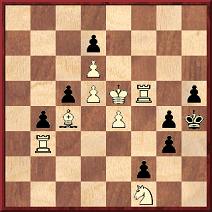
When contacting us by e-mail, correspondents are asked to include their name and full postal address and, when providing information, to quote exact book and magazine sources. The word ‘chess’ needs to appear in the subject-line or in the message itself.
| First column | << previous | Archives [12] | next >> | Current column |
Michael McDowell (Westcliff-on-sea, England) draws our attention to this problem by P.S. Milner-Barry on page 171 of Mate in Three Moves by B. Harley (London, 1943):

Mate in three.
The source given by Harley is ‘Morning Post, January 1923’, at which time Milner-Barry was aged 16.
Below is a specimen of Milner-Barry’s signature, from a letter to us dated 24 April 1979:
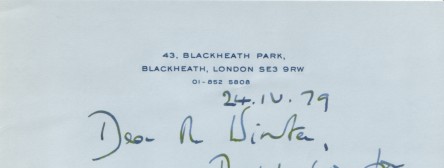

The two pictures in C.N. 3801 were reproduced from page 193 of Alt om Skak by B. Nielsen (Odense, 1943):

The occasion was a visit to the Bad Niendorf, 1934 tournament by Alekhine and Bogoljubow. Birger Flindtholt (Randers, Denmark) comments:
‘The first caption explains that Alekhine and Bogoljubow attended the tournament as guests. The second picture features Alekhine’s wife and Bogoljubow’s wife and children. I have always wondered about players attending tournaments as guests. Were they paid? And did they do anything besides posing for photographs and playing an occasional consultation game?’
From Peter Anderberg (Harmstorf, Germany):
‘The two photographs were taken on the afternoon of Monday, 2 July 1934 in Malente (Germany). During the “northern” tournament in Niendorf, participants, reporters and Alekhine and Bogoljubow (including families) went on a coach trip to the countryside of Schleswig-Holstein. This excursion was mentioned by Paul Krüger in his reports in the Hamburger Nachrichten of 4 and 5 July 1934.’
Joop Elderhorst (Rotterdam, the Netherlands) raises the subject of chess masters’ final resting places, and we plan a feature article on the subject if sufficient references can be assembled, with readers’ help. In the meantime, below are two photographs of Capablanca’s grave in the Colón Cemetery, Havana. They were taken by Bernardo Alonso García (who owns the copyright) and sent to us in 1994, with his permission, by Armando Alonso Lorenzo (Prov. Ciego de Avila, Cuba).

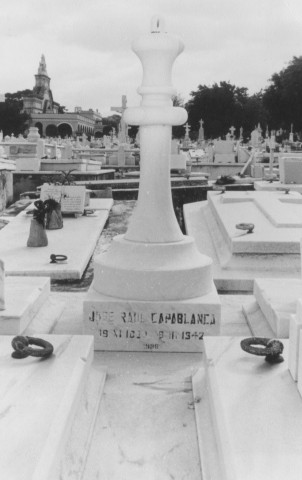
We offer a pictorial A to Z of chess prodigies up to circa
1950. The various claims are reported ‘flatly’, i.e. with no
expression of suspicion or incredulity at any of the more fanciful
statements found in print over the years. The term prodigy is,
moreover, interpreted here quite loosely, and we have been more
inclined to include ‘older youngsters’ from the nineteenth century
than from the twentieth. Rather than repeat information, games and
problems already given in C.N., in most cases we supply references
only. Many of the individuals featured were, in fact,
one-paragraph-wonders, about whose further exploits, if any,
nothing has been traced. In due course we plan to expand the
present item into a feature article, and any additions, criticisms
or other comments from readers will therefore be particularly
appreciated.
Allen, Richard
C.N. 2845 culled, from page 84 of CHESS, January 1951, a game won by Richard Allen in Normanton in 1950, at the age of six.
Ashby, Master
An account of the son of F.L. Ashby of Cheddleton, England, who
learned the moves of chess at the age of three, appeared on page
40 of the February 1920 BCM. See pages 54-55 of Chess
Explorations.
Baird, Lilian
Lilian Baird (1881-1977) was referred to on page 130 of Kings,
Commoners
and Knaves. An early composition by her was on page 103 of
the February 1891 BCM. Four of her problems were published
on page 14 of The Chess Bouquet by F.R. Gittins
(London, 1897), from which the photograph below is taken:
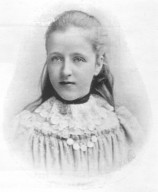
Lilian Baird
Billikopf, Jacob
Born circa 1882, Jacob Billikopf was featured on page 335 of the November 1897 American Chess Magazine, which praised him highly. See page 130 of Kings, Commoners and Knaves.

Jacob Billikopf
Blumenschein, Ernest
The conclusion to a game by Ernest Blumenschein against W.H. Smith in Dayton on 25 February 1890 was warmly received by Steinitz on page 155 of the May 1890 International Chess Magazine. Blumenschein was aged 15 at the time. See page 78 of A Chess Omnibus.
Boardman, Harry A.
The problemist Harry A. Boardman (1863-1935) was discussed in C.N. 3410, where several of his compositions as a child were given. He developed into a prominent figure in the problem world. The sketch below was published on page 1374 of the Scientific American Supplement, 25 August 1877.

Harry A. Boardman
Božić, Molorad
From page 453 of the November 1934 BCM: ‘Yugoslavia. A new infant chess prodigy has been discovered at Belgrade, Molorad Božić, the six-year-old son of an innkeeper in that city. Though he is already known as “little Alekhine”, it is perhaps best to await developments. Not all Samuel Rechevskis make good as he has done.’
Brereton, Master
A game won by him, at the age of seven, against his father, W.D. Brereton, in Pittsburg in 1898 was given on page 140 of Kings, Commoners and Knaves, from the Philadelphia Public Ledger of 10 February 1898.
Capablanca, José Raúl
A fine set of photographs of the young Capablanca accompanied an article about him by Olga Capablanca on pages 20-37 of Chessworld, May-June 1964. Almost all of his games as a prodigy were published in The Unknown Capablanca by D. Hooper and D. Brandreth (London, 1975). For additional data see our 1989 book on Capablanca, which also contained some rare photographs of the prodigy. Five further specimens are given below:
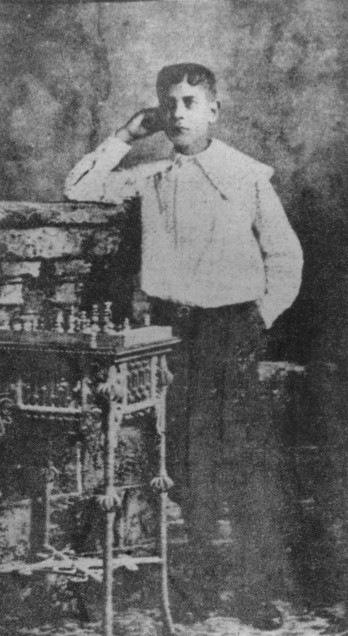
José Raúl Capablanca, aged ten
The next photograph was published on page 142 of El Fígaro, 30 March 1902. Capablanca is standing on the far right during a game between Corzo (Juan or Enrique?) and Manuel Márquez Sterling. Seated from left to right are: José Díaz, Eduardo Delgado, the Marqués de la Gratitud, Ramón Pardo and Gonzalo Herrera.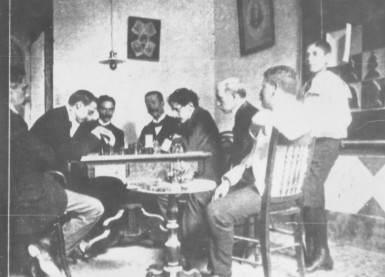
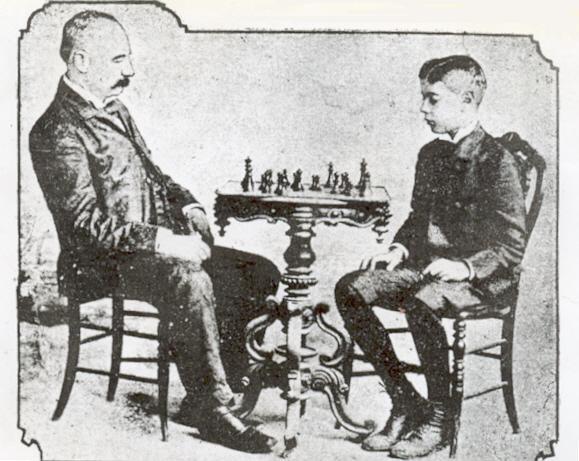
Antonio Fiol and José Raúl Capablanca
The picture below shows members of the Havana Chess Club in the cable match against the Manhattan Chess Club in April 1903: Manuel Márquez Sterling, Antonio Fiol, Enrique Corzo, Juan Corzo, José Antonio Blanco and José Raúl Capablanca.
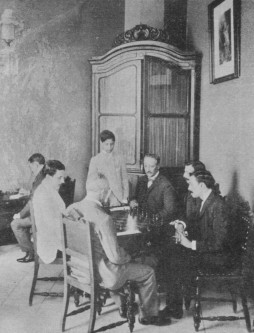
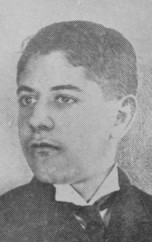
Cross, James
James Cross came to prominence as a 16-year-old, being praised on page 32 of the December 1946 Chess Review. Two of his games were given on pages 125-126 of A Chess Omnibus.

James Cross
del Sel, Luis Enrique
Page 374 of the October 1921 BCM reported from the
April-June 1921 Revista del Club Argentino de Ajedrez that
Luis Enrique del Sel, born in Santa Rosa on 25 July 1908, learned
chess at the age of nine and was a strong player. See page 55 of Chess
Explorations.
Derrickson, George H.
The winner of a famous brilliancy over the board, George H.
Derrickson was also an accomplished problemist. He died in
Philadelphia in 1862 aged about 17. See pages 229-230 of Kings,
Commoners
and Knaves and pages 343-344 of A Chess Omnibus. The
photograph of him below (the only one known) is reproduced
courtesy of the Library Company of Philadelphia.
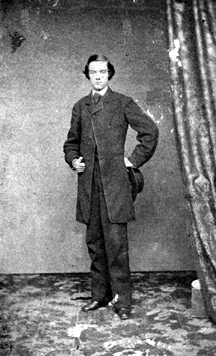
George H. Derrickson
Eichholz, Elliot Franklin
A problem composed by Elliot Franklin Eichholz at the age of five was published on page 132 of the May-June 1917 American Chess Bulletin. See page 234 of Kings, Commoners and Knaves.
Elsner, Max
Page 356 of the November 1885 Deutsche Schachzeitung gave a game Max Elsner won against his mother in Klein Wanzleben on 13 November 1885 when he was six and three-quarters, although, in an unresolved discrepancy, the magazine also stated that he was born on 10 February 1871. See pages 129-130 of Kings, Commoners and Knaves.
Fairhurst, William Albert
A victory by William Albert Fairhurst at the age of 18 against Boris Kostić (Manchester, 1922) was given on page 230 of the Chess Amateur, May 1922 and on page 80 of A Chess Omnibus.
Fleischman, Simon and Blanca
Pages 52-53 of Chess Explorations quoted from La
Estrategia Mexicana, October 1876 a reference to ‘Miss
Blanca Fleischmann [sic], the celebrated and distinguished
girl from Buffalo in the United States’, a problemist and player.
As noted in C.N. 3402, the chess column by Sam Loyd in Scientific
American Supplement, 19 January 1878 (page 1708) gave a
problem by Simon Fleischman and reported that both he and his
sister had ‘developed a remarkable aptitude for chess and have
published many excellent problems’.
Flores, Rodrigo
Rodrigo Flores was born in Chile in 1913. His activities as a prodigy were presented in C.N. 3046, with four games played in the 1920s.
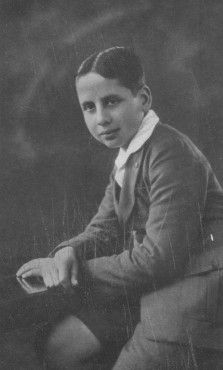

Rodrigo Flores
Graef, Charles and Frederic
A game between these brothers (aged 13 and 14 respectively) in Long Island circa 1857 was given on pages 241-242 of the Chess Monthly, August 1857 and reproduced on page 76 of A Chess Omnibus.
Griffith, William H.
Born on 18 January 1927, a prodigy from Memphis who was able to
set up the 32 chess pieces correctly at the age of two and a half,
according to a report in the Commercial Appeal of 9 March
1930 which was reproduced on page 84 of the April 1930 American
Chess Bulletin. See pages 130-131 of Chess Explorations.
Gromer, Aristide
C.N.s 2945 and 2946 discussed Aristide Gromer (born in 1909), on the basis of reports in La Stratégie, the Chess Amateur, the BCM and the American Chess Bulletin. The score of his loss to V. Kahn in Paris, 1923 was included.
Gueffier
As a 12-year-old he drew against Janowsky in a simultaneous exhibition in Paris (BCM, March 1894, page 89). As mentioned on page 130 of Kings, Commoners and Knaves, it remains to be established whether he was the same player who drew against Emanuel Lasker in Paris in 1909.
Hall, J.
The daughter of W.W. Hall, whom she beat, when she was aged nine, in a game at McGregor, Texas in 1888. It was published in the St John Globe of 20 April 1888 and reprinted on page 77 of A Chess Omnibus.
Johnson, Craig Adams
Page 35 of the American Chess Bulletin, February 1919 stated that at the age of six Craig Adams Johnson of Utica drew his game against Frank Marshall in a simultaneous exhibition.
Kirkham, J. Henry
When aged 13 J. Henry Kirkham of Newington was mentioned on page 334 of the American Chess Journal, May 1879 as a good player and problem-solver.
Lengden, John
Born in Manchester on 30 October 1902. A biographical note and game were given on pages 119-120 of the March 1912 BCM. See page 54 of Chess Explorations.

John Lengden
Leonard, James A.
A New York player (1841-62) who was discussed on pages 133-140 of Kings, Commoners and Knaves and was notable for his blindfold prowess. A monograph on him by John S. Hilbert is being published by McFarland & Company, Inc. later in 2005.
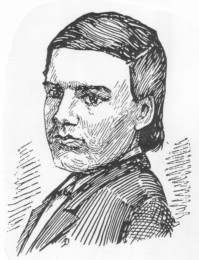
MacLeod, Nicholas
Nicholas MacLeod (1870-1965) was a participant at New York, 1889. An earlier tournament performance of his was highly praised on page 230 of the June 1885 BCM. Jeremy Gaige provided a biography of MacLeod in C.N. 479.
Martínez, Charles S.
Charles S. Martínez (1868-1941) was the son of Dión M. Martínez. A combinational finish to his game against W.E. Wayte in Germantown, 1885 was published by Steinitz on page 153 of the May 1885 International Chess Magazine. See page 78 of A Chess Omnibus.
Mikeladze, Iberie
La Stratégie, 15 August 1885 (page 247) reported that Iberie Mikeladze was an eight-year-old prodigy, the son of Prince Mikeladze. A game of his against Bakradze in Kutais, 1886 was given. See page 76 of A Chess Omnibus.
Mora Iturralde, María Teresa
The Cuban prodigy to whom Capablanca gave lessons, as he reported in My Chess Career. See page 56 of Chess Explorations and pages 122-123 of A Chess Omnibus. Her year of birth is usually given as 1907, but C.N. 3468 discussed the evidence that she was born five years earlier.

María Teresa Mora and Edward Everett (November 1916)
Morphy, Paul Charles
Almost everything known about Morphy as a prodigy is to be found in Paul Morphy The Pride and Sorrow of Chess by D. Lawson (New York, 1976). As far as we are aware, no picture of Morphy as a child has been found.
Muffang, André
A game won by André Muffang (1897-1989) against A. de Poplawski in Paris on 26 March 1913 was published in La Stratégie, April 1913, pages 146-147. See page 79 of A Chess Omnibus.
Nadel, Siegfried
In its report on the Hastings, 1930-31 congress, pages 63-64 of the February 1931 BCM stated that ‘S. Nadel, the 16-year-old boy from Berlin, gave a simultaneous blindfold display against eight players. Most of the games had to be adjudicated, the final figures being: 2 wins, 4 draws and 2 losses. The players who scored wins against him were Mrs Wheelwright and D.A. Breach.’ Page 60 of the same issue recorded that Nadel had finished last in the Major A tournament in Hastings, but: ‘He is only 16 years of age and has been playing chess for only two years. To be a blindfold exponent on such short experience is really remarkable.’
Napier, William Ewart
Comprehensive coverage of William Ewart Napier as a prodigy was provided in Napier The Forgotten Chessmaster by John S. Hilbert (Yorklyn, 1997).
Neimark, Celia
Page 171 of the American Chess Bulletin,
September-October 1921 reported that Celia Neimark, aged seven,
had defeated the Ohio State Champion, Irving Spero. The score was
reproduced on pages 79-80 of A Chess Omnibus. The
photograph of her below in Cleveland (with an inverted board) was
published on page 206 of the December 1921 issue of the Bulletin:

Celia Neimark
Norton, Frank
A problem composer born in 1866 who gained attention in the 1870s. See page 366 of A Chess Omnibus and C.N.s 3402 and 3406 for further information (including problems and games).
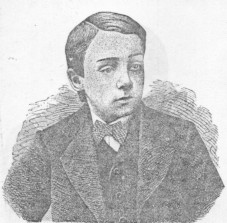
Frank Norton
Pomar Salamanca, Arturo
Born in 1931. The mid-1940s saw the publication of two monographs, Mis Cincuenta Partidas con Maestros (Madrid, 1945) and La Vida de Arturito Pomar by J.M. Fuentes and J. Ganzo (Madrid, 1946). Two specimens of his play were given on pages 114-116 of A Chess Omnibus.

Arturo Pomar, aged five
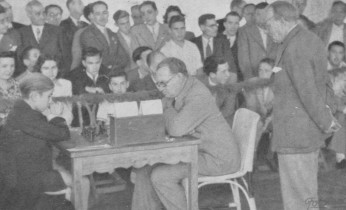
Arturo Pomar in play against Alexander Alekhine, Gijón, July 1944

Savielly Tartakower and Arturo Pomar, London, 1946
Reeve, Birdie
Chessplayer and vaudeville typist. See C.N.s 3572, 3612, 3647 and 3668.
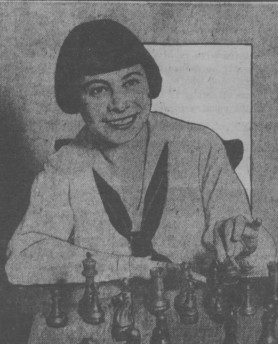

Birdie Reeve
Reshevsky, Samuel
A selection of games played by Reshevsky between 1920 and 1922
was presented in C.N. 1518 (pages 61-66 of Chess Explorations).
For the most comprehensive collection, see pages 1-19 of Samuel
Reshevsky by Stephen W. Gordon (Jefferson, 1997). An
addition was given on page 98 of A Chess Omnibus (an item
based on pages 122-127 of La Stratégie, June 1920). A
colourful report from page 2 of the Boston Post of 4 April
1921 was quoted on pages 258-259 of Chess Explorations,
which also referred to the claims seen in the 1990s, though seldom
since, that Reshevsky was born not in 1911 but in 1909. Below is
the title page of a rare early monograph on the prodigy, published
by Bernhard Kagan in Berlin in 1920:
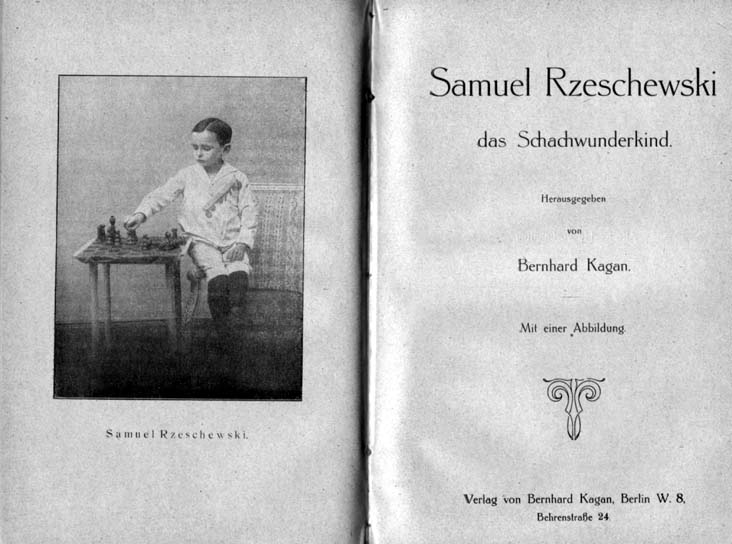
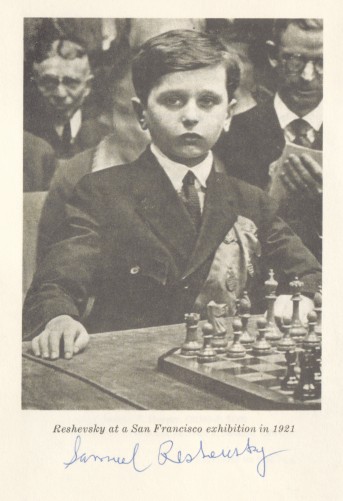
The photograph below was taken before a 20-board simultaneous display by Reshevsky in Cleveland on 27 January 1921:
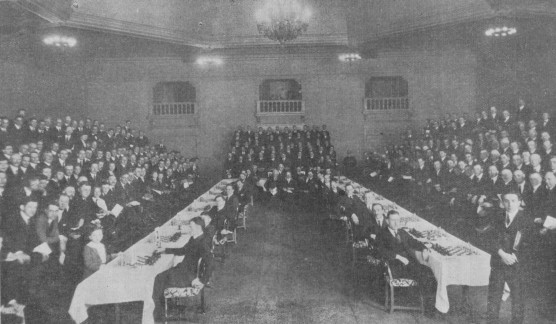
Roberts, John Drew
John Drew Roberts (1864-1931) was discussed, with several specimens of his play, on pages 131-133 of Kings, Commoners and Knaves. For a further example, see page 77 of A Chess Omnibus.
Rohner, W.A.
W.A. Rohner of Hamilton, Australia was mentioned on page 149 of La
Stratégie, April-May 1879 and page 334 of the American
Chess Journal, May 1879 as a 12-year-old who had won a local
tournament.
Rolfe, William J.
A photograph of William J. Rolfe Jr., taken when he was aged three, appeared on page 39 of the February 1932 American Chess Bulletin. See also page 143 of A Chess Omnibus.
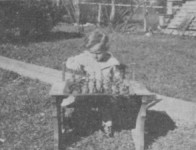
William J. Rolfe
Salot, Henry
A six-and-a-half-year-old prodigy from Philadelphia, according to a report on page 275 of the August 1916 BCM, taken from L’Eco degli Scacchi. See page 54 of Chess Explorations.
Saunders, Elaine
Born in 1926, Elaine Saunders was a celebrated prodigy in the 1930s, and her exploits were well documented in British chess periodicals of the time. On 29 February 1952 she married the chess writer David Brine Pritchard (CHESS, April 1952, page 129).
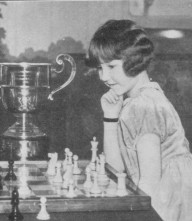
Elaine Saunders
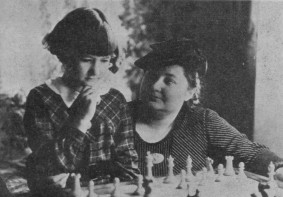
Elaine Saunders and Vera Menchik
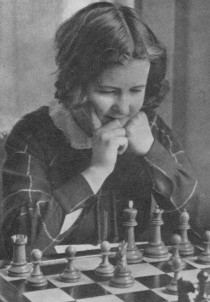
Elaine Saunders
Spalding, F.S.L.
A prodigy solver from Plymouth, England who was discussed on page 142 of the March 1902 BCM. See page 54 of Chess Explorations.
Stella, Mademoiselle
An account was published on page 177 of La Stratégie, 15
June 1895. See C.N. 3145.
Sumar, Julio
Born in 1932, Julio Sumar (from Peru) was discussed, with an illustrative game, on page 254 of the August 1947 BCM. See pages 55-56 of Chess Explorations.
Thompson, C.
On page 219 of the July 1890 International Chess Magazine Steinitz published a game won by C. Thompson against J.D. Elwell in Brooklyn, 1890. Thompson was aged 18. See pages 78-79 of A Chess Omnibus.
Viesca, Andrés Ludovico
Andrés Ludovico Viesca was a Mexican prodigy born in Parras de la Fuente on 8 April 1869. A win against José Martí was published in El Fígaro of 8 October 1893. See pages 52-53 of Chess Explorations.
Wahrburg, David
At the age of 14 David Wahrburg of Stuyvesant High School drew against Capablanca in a simultaneous display at the Manhattan Chess Club, as reported on page 42 of the March 1922 American Chess Bulletin.
White, Robert C.
According to pages 73-75 of the April 1917 American Chess Bulletin, at the age of 12 Robert C. White held Frank Marshall to a draw in a 144-board simultaneous exhibition in Buffalo on 8 March 1917. See page 130 of Kings, Commoners and Knaves.
Woolf, George William
Born in South Hackney, London on 22 October 1893, and the subject of a feature, including a game, on pages 414-415 of the October 1901 BCM. See page 53 of Chess Explorations.

George William Woolf
Zaremba, Paul D.
A photograph of Paul D. Zaremba at the age of 21 months was published on page 39 of the February 1932 American Chess Bulletin. See also page 143 of A Chess Omnibus.

Paul D. Zaremba
As regards Albert B. Hodges’ alleged involvement in films in the second decade of the twentieth century, David Picken (Greasby, England) writes:
‘I have searched in the Internet Movie Database and the All Movie Guide database but have found nothing on Hodges, although the four films you mentioned are covered and cast-lists are given. It may be that Hodges was an “extra” or a very small bit part player who would not normally be credited. The films are:
War Brides. Released in 1916 as a short (eight minutes) by Selznick Pictures Corporation and directed by Herbert Brenon. The cast included Alla Nazimova and Richard Barthelmess.
The Auction Block. Released in 1917 and directed by Laurence Trimble.
Empty Pockets. Released in 1918 and directed by Herbert Brenon.
The False Faces. Released in 1919 and directed by Irvin Willat. Brenon appears not to have had a connection with this film.’
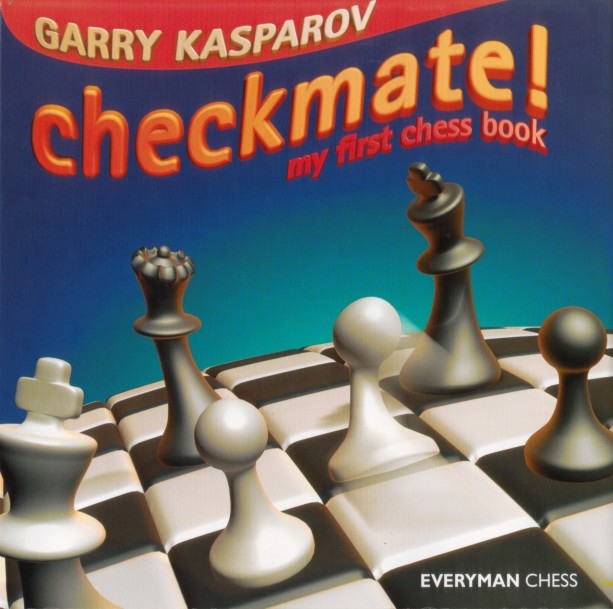
From Avital Pilpel (New York):
‘In 2004, Everyman Chess published Checkmate! My First Chess Book by G. Kasparov. As the title implies, the book is intended for children who are absolute beginners. About half of the 96-page hardback is devoted to the rules of the game and the remainder to “tactical play” (i.e. fork, pin and skewer), common checkmates, and basic opening and endgame principles of the “don’t-move-your-queen-out-early” sort. Every chapter is printed on (glossy) paper of a different color (red, yellow, green, etc.). The book has numerous computer-generated 3-D illustrations.
While this is hardly the first book by a world champion aimed at beginners, it is extremely basic, which makes one wonder to what degree Kasparov was involved in the actual writing. On the other hand, the book contains an introduction by Kasparov (complete with signature), and there is no mention of a co-author, although an “Editor” (Byron Jacobs) is named, and the book’s “Design, typesetting, and illustrations” are credited to Horatio Monteverde. Does anybody know if Kasparov is indeed the author?’
Joshua B. Lilly (Martinsville, VA, USA) raises the subject of a famous game, Rossolimo v Livingstone, New York, 1961, asking for specifics as to a contemporary source, the occasion and Black’s identity:
1 e4 d5 2 exd5 Qxd5 3 Nc3 Qa5 4 d4 Nf6 5 Nf3 Bg4 6 h3 Qh5 7 Be2 Nc6 8 O-O Bxh3 9 gxh3 Qxh3 10 Ng5 Qh4 11 d5 Ne5 12 Bb5+ c6 13 dxc6 bxc6 14 Nd5 O-O-O 15 Ba6+ Kb8 16 Bf4 Rxd5 17 Bxe5+ Ka8
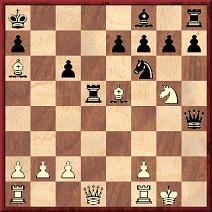
18 c4 Qxg5+ 19 Bg3 Rxd1 20 Raxd1 Nd5 21 cxd5 c5 22 b4 c4 23 Rd4 e5 24 dxe6 Bxb4 25 Rd7 Rb8 26 Rfd1 Be7 27 exf7 c3 28 f8(Q) Resigns.

Max Euwe
Glenn Giffen (Toronto, Canada) and Mark Weeks (Brussels, Belgium) raise the subject of the ‘champion for one day’ claims sometimes seen regarding Euwe, and for readers’ convenience we revert here to C.N. 3321, where Christian Sánchez (Rosario, Argentina) wrote:
‘I have repeatedly read that in 1947 Euwe was champion for one day; for instance, page 127 of the second edition of The Oxford Companion to Chess says:
“With the death of Alekhine in 1946 the world championship title was vacant. To deal with the matter FIDE delegates assembled in 1947, and at the same meeting the Soviet Union became a member. The delegates decided that Euwe, as the previous title-holder, and indeed the only ex-champion still alive, should become world champion pending the next contest. The next day the Soviet contingent arrived, having been delayed en route, had the decision annulled, and the title left vacant. Thus he would say wryly that he had been world champion for one day in 1947.”
However, according to the minutes of the FIDE Congress, that decision was never taken. Below is the Spanish version of the two reports on the sessions of 1 and 2 August 1947 respectively, as published in El Ajedrez Argentino, November-December, 1947, pages 298-300):
“La cuestión del Campeonato del mundo se discute y después de votación de diversos proyectos se inclinan los delegados, cuando el Dr. Euwe abandonó la sesión, a la proclamación del mismo como Campeón del mundo con la obligación de jugar un match con Reshevsky y luego el ganador de enfrentarse con Botvinnik. Sres. Louma y Rogard juzgan esta determinación como peligrosa en vista de la ausencia del delegado soviético y proponen aplazar la resolución en espera de la Delegación de la U.R.S.S. Esta proposición fue aceptada.”
“Presentes los mismos Delegados de la sesión anterior y los Delegados soviéticos señores Pochegnikov, Ragozin y Yudovich y el intérprete S. Malolev. (...) Luego se discute la reglamentación del Campeonato del mundo. Se acepta por unanimidad jugar un torneo de seis grandes maestros como fue fijado en la Asamblea General de Winterthur, 1946. El torneo se inicia el 1º de marzo de 1948 en Holanda jugándose allí la mitad del torneo. Después de un intervalo de 15 días como máximum se jugará la segunda mitad del torneo en URSS de modo que el torneo terminará el 31 de mayo de 1948. El torneo se jugará entre los maestros designados y presentes al iniciarlo y en el caso de que no se llevara a cabo decidirá la Asamblea General próxima otro reglamento.”’
In expressing gratitude to Mr Sánchez for these quotes, C.N. 3321 commented that we had been unable to find an English version of the minutes of FIDE’s 1947 Congress (which remains the case today). The first passage above states that after Euwe left the room the delegates decided to proclaim him world champion, but with an obligation upon him to play a match against Reshevsky and with the winner of that match then having to play Botvinnik. However, Messrs Louma and Rogard regarded this proposal as dangerous in view of the absence of the members of the Soviet delegation, and it was decided to postpone the resolution, pending their arrival. The second text above states that after they had come the following day the six-man match-tournament was agreed upon.
C.N. 3321 furthermore requested substantiation (not yet found) for the statement in The Companion that Euwe himself ‘would say wryly that he had been world champion for one day in 1947’ and for the assertion on pages 270-271 of Max Euwe by Alexander Münninghoff (Alkmaar, 2001) that in 1947 ‘Euwe was world champion for two hours’. We also wondered about the identity, and even existence, of the ‘someone’ on page 9 of part two of Garry Kasparov on My Great Predecessors (London, 2003):
‘Euwe held the crown for only two years (1935-37), and someone once christened him “king for a day”, in view of Alekhine’s indifferent form.’
‘She is a genius.’ That was Alekhine’s observation on the 12-year-old Elaine Saunders after playing her in a simultaneous exhibition in London on 22 January 1938. From page 190 of CHESS, 14 February 1938:
‘Dr Alekhine was televised by the British Broadcasting Corporation in January, “lookers-in” seeing him make, once again, the move which regained for him the world’s championship.
On 22 January he played simultaneously against 30 of Kent’s strongest players and after four and a half hours had won all but three ... Twelve-year-old Elaine Saunders, British girl champion, covered herself with glory by holding out to the very end, succumbing in a rook-and-pawn endgame in the very last game to finish. Dr Alekhine, speaking afterwards, said, “She is a genius”.
... [Elaine Saunders] became famous overnight – as far as the general public was concerned – as a result of her fine show against Alekhine. Pictures of her with eye to a telescope, boxing a punchball, walloping her father blindfold, etc. were published in many of the daily papers.’
A photograph (featuring Alekhine in play against R.C. Noel-Johnson, Elaine Saunders, C. Chapman, H.H. Cole, H. Israel and W.J.E. Yeeles) of the display at the Charing Cross Hotel, London was published on page 115 of the March 1938 BCM:
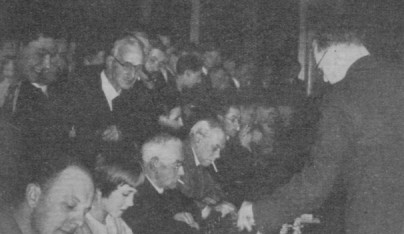
We have never seen the moves of her game against Alekhine, but below is a victory she scored in a simultaneous display given by another eminent figure:
Rudolf Spielmann – Elaine Saunders
Occasion?
Sicilian Defence
1 e4 c5 2 Nf3 Nc6 3 d4 cxd4 4 Nxd4 d6 5 c4 Nf6 6 Nc3 g6 7 Be2 Bg7 8 Be3 O-O 9 Nxc6 bxc6 10 h4 Qa5 11 Qd2 Ng4

12 h5 Nxe3 13 Qxe3 Qb4 14 Qd2 Be6 15 hxg6 fxg6 16 a3 Qc5 17 O-O-O Rxf2 18 b4 Qe5 19 White resigns.
This score is taken from a feature on Elaine Saunders on pages 263-264 of the Australasian Chess Review, 31 October 1938, which commented:
‘We do not intend to wallow in newspaper sensationalism about this little champion. Our readers will be more interested in the following remarks made by her father, Mr H. de B. Saunders, in response to our request for Elaine’s photo.
“I should like to stress the point that despite the reports of the ‘sensational press’ Elaine is quite an ordinary child, and not a ‘prodigy’. She is fond of all outdoor sports, and is especially keen on swimming, riding, skating and ball games. All the same, she has chess to thank for making innumerable friends both at home and abroad. She is playing three sets of correspondence chess with German opponents at the moment; all of whom are otherwise quite unknown to her.
Her successes have been almost entirely due to the kind and patient coaching of our friend Mr C.D. Locock (whose Imagination in Chess you have reviewed in the ACR). Although a veteran, Mr Locock still finds time to visit girls’ schools and teach chess; his service in this direction being entirely voluntary. Without his help, Elaine would never have risen above the ranks of ‘woodshifters’ and she bears him a considerable debt of gratitude.”’
Below is the illustration which accompanied the article in the Australasian Chess Review:
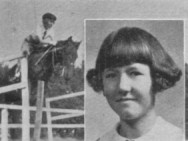
Elaine Saunders
In 1939 P.W. Sergeant dedicated to her his book An Introduction to The Endgame at Chess, as follows:
‘Dedicated to Miss Elaine Zelia Saunders because she doesn’t (at present) like the Endgame.’
We wonder if any other chess book has been dedicated to somebody as young as 13.
W.D. Rubinstein (Aberystwyth, Wales) comments on the dearth of Soviet prodigies mentioned in C.N. 3812, and we should certainly welcome documentation enabling the list to be expanded. Meanwhile, we invite, in particular, information on a youngster referred to by Nikolai Grekov in his reminiscences quoted (from where?) by J. du Mont on pages 14-16 of Capablanca’s Hundred Best Games of Chess by H. Golombek (London, 1947):
‘The following curious episode took place during the 1936 Moscow tournament. In the interval a 13-year-old schoolboy, Pavel Pomoschnikov, approached Capablanca and in fluent French challenged the ex-champion to a game. Not wanting to distress the boy, Capablanca consented. Having lost three games in succession, Pavel Pomoschnikov demanded a handicap of a queen. Capablanca replied that a queen was too much. The boy then solemnly declared that in ten years he would play against Capablanca as an equal and with better success. The Cuban champion advised the young champion to prepare well for the coming match and presented him with an autographed copy of his book on chess.’
Chris Ravilious (Eastbourne, England) reports that in 1995 he brought out a monograph on a prodigy mentioned in C.N. 3812, Lilian Baird, under the title Lilian An Episode in Chess Problem History.
From John Blackstone (Las Vegas, NV, USA):
‘In Budapest, 1912 there was a theme tournament (Queen’s Gambit, Tarrasch Defense), won by Schlechter and Marshall, who both scored +1 –0 =4. I am trying to determine whether the game between Marshall and Vidmar was actually played or was forfeited by Vidmar.
The occasion was the last round; a win by either Marshall or Vidmar would give him equal first place with Schlechter. I have found no mention of the game in the writings of either Marshall or Vidmar, and it is the only game from the tournament which has not been traced.’
Irving Chernev gave the crosstable on page 71 of Wonders and Curiosities of Chess (New York, 1974), making the point that Vidmar finished (equal) last even though he won more games than any other player. By scoring a zero against Marshall, Vidmar ended up equal bottom, whereas a victory would have made him the joint winner.

C.N. 2581 enquired whether readers could identify anyone in the above photograph. Since no information was received, we ask again now.
Glenn Giffen (Toronto, Canada) asks about Spain’s status within FIDE after the Second World War and, in particular, enquires when the country was readmitted by the Federation.
On pages 169-171 of the November 1946 Schweizerische Schachzeitung the Swiss delegate Erwin Voellmy reported that at the FIDE Congress (Winterthur, 25-27 July 1946) Spain had been represented by its Consul in Zurich and that the FIDE delegates of Czechoslovakia, the Netherlands and France had been ordered to oppose Spain’s admission. Such a decision was duly taken.
Below, from page 170 of the Swiss magazine, is a photograph of the officials:
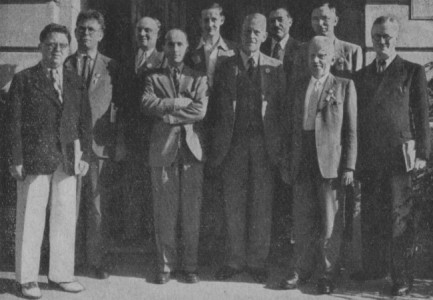
Left to right: K. Opočenský, H. Meyer, J. Louma, G.C. dal Verme, B.H. Wood, A. Rueb, M. Berman, E. Voellmy, M. Euwe, F. Peeters
Voellmy’s report on the following year’s Congress (The Hague, 30 July-2 August 1947) was published on pages 154-155 of the October 1947 Schweizerische Schachzeitung. He noted that at the proposal of the Soviet Union the issue of Spain’s membership was entrusted to the Central Committee, which was considered likely to annul the exclusion of Spain:
‘Cas de l’Espagne: Sur proposition de la Tchécoslovaquie, le Congrès de Winterthour avait exclu l’Espagne jusqu’à la prochaine assemblée (sous la forme d’une non-réadmission). Le Congrès de la Haye s’est occupé à nouveau de la question et, sur proposition des Russes, a remis la décision au comité central; il est assez probable que celui-ci cassera la sentence d’exclusion.’
The circumstances in which the Central Committee’s decision was eventually taken are not yet clear to us, but certainly Spain attended the FIDE Congress the following year (Saltsjöbaden, 11-15 August 1948), being one of the 23 countries listed on, for instance, page 181 of the November 1948 Schweizerische Schachzeitung.
The other issue is the Soviet Union’s role in the exclusion and eventual readmission of Spain. From page 63 of the December 1946 CHESS:
‘The USSR has not joined the International Chess Federation (FIDE). At the last FIDE Assembly Spain, who had been a founder-member and had paid its dues throughout, was ejected in the hope that the Soviets would join; the sacrifice has deeply wounded Spanish sentiment.’
On the other hand, page 272 of the September 1948 CHESS reported that the Soviet representatives objected to the presence of the Spanish delegate at that year’s FIDE Congress.
We hope that readers can assist us in building up further documentation on this matter.
A brief passage from the FIDE Congress report on pages 271-272 of the September 1948 CHESS concerns a less substantial matter on which we would nonetheless also welcome particulars:
‘From Brazil came the suggestion of a new improved chess notation; there was one of the few real laughs of the Assembly when Dr Voellmy of Switzerland and C. Kottnauer of Czechoslovakia (world famous as writer and player respectively) who had been deputed to study it confessed that after two days’ examination of the system they were still far from comprehending it.’

Mikhail Botvinnik
Page 249 of the August 1948 CHESS stated:
‘We hear that Mikhail Botvinnik is the subject of a new Russian documentary film, World Champion.’
What more is known about it?
C.N.s 360 and 1078 (see pages 109-110 of Chess Explorations) provided an outline of court cases involving Isidor Gunsberg. In one of them, during the Great War, he sued for libel, and here we provide a more detailed account of the affair.
In his chess column on page 4 of the (London) Daily Telegraph of 26 June 1915 Gunsberg wrote:
‘The Hostile Series. Neither Huxley nor Todhunter, though they have learnedly dealt with the average run of chances, have done sufficient justice to the problem of the hostile series. The subject is worthy of the attention of mathematicians and philosophers. Instinct is very often a more unfailing guide than the mathematician or philosopher can be. The bridge player, or any other player for the matter of that, who ceases to play when he thinks the hostile series is approaching does the right thing. At the moment we have the feeling that we are the victim of a hostile series affecting our problems. Why it should be that for many months we may not have an unsound problem, and that all at once a series of second solutions should crop up, we cannot explain, except on grounds of a regular occurrence of hostile series.’
A week later, on page 4 of the Evening News of 3 July 1915, the chess column (‘by the Chess News Agency’) included the following paragraph until the heading ‘The Hostile Series’:
‘A wonderful excuse for making blunders has been evolved by one sapient scribe of the chess world. Apparently he has been publishing more unsound problems than usual, as nearly every problem which has appeared in his column for some time has had at least two solutions; and he moralises thus: “At the moment we have the feeling that we are the victims of a hostile series affecting our problems. Why it should be that all at once a series of second solutions should crop up we cannot explain.”’

The author of those words was A.W. Foster, and Gunsberg sued for libel. When the case came to court at the end of the following year the Evening News of 8 December 1916 reported:
‘The defence denied that the words in question were libellous. Justification and fair comment were also pleaded.
... A long list of newspapers for which Mr Gunsberg had acted as chess editor was given by counsel
... Mr Mayer [Sylvain Mayer, K.C., counsel for the plaintiff] then pointed out that extra marks were given by Mr Gunsberg to solvers who found two solutions to a problem in the Daily Telegraph.
It was impossible – said counsel – to avoid giving problems with two solutions occasionally. A second solution to a magnificent problem by Mr Blackburne was found 42 years after it was published.
In 1915 the proportion of problems in the Daily Telegraph with two solutions was not abnormal. There were three cases of misprints.
Counsel complained that in the passage quoted from the Daily Telegraph the words “For many months we have not had an unsound problem” were omitted.
Mr Gunsberg, giving evidence, said that the proportion of unsound problems given in certain other newspapers was greater than that in the Daily Telegraph.
Mr Hume Williams, cross-examining, asked the witness if eight out of 11 problems that appeared in a certain period were not unsound.
The witness replied that three misprints were included.
With regard to a misprinted problem, the judge asked why a white pawn should not have been a white knight.
Mr Hume Williams: “Your lordship must be careful; you shock the chess experts.”
Mr Gunsberg agreed that “a hostile series” meant a run of bad luck. He had experienced such things at Monte Carlo.
Mr Williams: “You don’t shock me, Mr Gunsberg, but you may shock the chess experts. (Laughter.)
The witness explained that his bad luck was that the unsound problems came together in a bunch.
Replying to a question, the witness said that nobody could guarantee the soundness of a chess problem ...’

Isidor Arthur Gunsberg
The Times of 9 December 1916 also reported the case:
‘Counsel, referring to the alleged libel, contended that Mr Gunsberg had made no blunders. The occasional publication of problems with two solutions could not be avoided.
The plaintiff, in evidence, denied that he had committed blunders. Problems had sometimes been published which had no solution at all. They afforded just as much amusement as those which had solutions.
Mr Hume Williams: “They must last longer any way.” (Laughter.)
Mr Benjamin Glover Laws, the editor of the problem department of the British Chess Magazine, said that he had always had a very high opinion of Mr Gunsberg. It took months, and in some cases years, to construct a problem and many days properly to analyse it in order to detect flaws. A prize problem was often examined by hundreds of persons. Some prize problems, although composed by eminent composers, had been found to be unsound after many years. It was impossible to avoid such a thing.
Mr Justice Bray: “It is just like a Judge’s making a mistake in law. You don’t call that a blunder.” (Laughter.)’
The following report was published in the Evening News of 12 December 1916:
‘The action in which Mr Isidor Arthur Gunsberg, the chess master and chess journalist, is asking for damages for libel against the Associated Newspapers, Ltd., and the Chess News Agency was continued before Mr Justice Bray and a special jury today.
... The effect of the paragraph [in the Evening News] was that recently published problems were “more unsound than usual” and it is stated by the defence that eight out of the 12 problems had two solutions.
Mr Gunsberg agrees that problems with two solutions were published. He contends that the average percentage of unsound problems published by him is less than normal, and that it is impossible to guarantee the soundness of a problem.
Mr A. Guest, a well-known player and problem composer, was called as a witness for Mr Gunsberg. He has been chess editor of the Morning Post for 33 years.
This witness said that in spite of the care devoted to the matter he had had 21 unsound problems out of 260 in his column during the past five years.
The word “blunder” had been used in the Evening News paragraph.
Replying to counsel, Mr Guest said that he did not consider that “eight oversights spelled one blunder”.
Mr J.H. Blackburne, the veteran British champion, winner of many international tournaments was the next witness. He is now 77 [sic] years old. He had known Mr Gunsberg – said he – for 50 years.
Mr Blackburne told the court that he did not think it was a blunder to publish problems with two solutions, as he had done the same thing himself.
He recalled a problem that he composed and published in 1847 [sic]. It was examined by five experts including himself, for days and was passed as sound. Two years ago “some Argus-eyed individual in Devonshire” discovered a second solution.
Mr Hume Williams, K.C. (for the defendants): “It had a long though unsound life.” (Laughter.)
Mr Hume Williams asked if it would not point to carelessness if the second solution were easily discoverable.
Mr Blackburne replied that he had not examined the problems in question. The second solutions, or cooks, were usually more difficult to find than the intended solutions.
Opening the case for the defendants, Mr Hume Williams said Mr Gunsberg had not suffered one farthing damage by what was published.
He had himself, in the Daily Telegraph, spoken of the second solutions, and attributed them to a hostile series of bad luck against him.
Mr Hume Williams spoke of the unsound positions in detail. He asked Mr Herbert Jacobs, a distinguished player, who was appearing with Mr Mayer, K.C. on the other side, whether a “rook” was not the same thing as a knight.
Mr Jacobs: “A rook is a castle.”
The Judge: “Do you really pretend, Mr Hume Williams, that you do not know?”
Mr Hume Williams: “Your lordship must not say ‘pretend’. I shall bring an action against your Lordship.” (Laughter.)
Mr A.W. Foster, the writer of the paragraph, said it was supplied to the Evening News by the Chess News Agency.
The witness said he had combined the distinction of being president of the Cambridge University Chess Club with being vice-president of the Oxford University Club.
“I was amused and surprised”, said Mr Foster, “to find that a chess expert should regard chess as being on a level with a game of chance.”
The Judge: “You were shocked?”
Mr Foster: “My chess conscience was shocked.”
The witness then said he had no malicious feeling towards Mr Gunsberg. He was merely poking a little mild fun at him without mentioning his name.
The witness pointed out that four of the eight unsound problems in question were two-movers and four three-movers. A second solution in a two-mover should be easily detected.
Cross-examining, Mr Mayer pointed out that early in the year the Field published unsound problems on three successive weeks.
The Judge: “Which is the bigger man, the chessplayer or the problem expert?”
Mr Foster: “The type of men is entirely different.”’
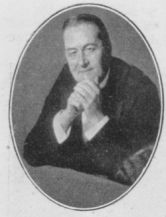
Alfred William Foster
A similar account of the proceedings was published in The Times of 13 December 1916, which, however, gave 1874, rather than the impossible 1847, in the account of Blackburne’s evidence and added the following details:
‘Mr A.W. Foster ... believed that the plaintiff had made a blunder and had evolved a very clever excuse. He imputed carelessness.
Cross-examined by Mr Sylvain Mayer. He could not say if 16 out of 77 problems published in the British Chess Magazine were unsound. He was acquainted with Grimshaw’s famous problem published for 20 years in every country before a second solution was discovered. He had never himself composed or published a problem and was not a chess master.
His use of the words “sapient scribe” of the plaintiff was sarcastic, and he was quite content to be classed by Carlyle with ironical people as a “pest of society”. Carlyle had also said that the 40 millions were mostly fools.
Mr Tinsley said that for 10½ years he was chess editor of The Times, which was then the leading newspaper for problems. His percentage on 3,000 problems over this period was 5% unsound. That eight out of 12 should prove unsound could be due only to carelessness in scrutinizing them.
Cross-examined by Mr Mayer. He once published a hostile American series, in which the percentage of unsound problems was from 10 to 15.’
The verdict was announced in, inter alia, the Daily Telegraph of 13 December 1916:
‘Gunsberg v Associated Newspapers (Ltd.) and Another. After an hour’s deliberation in private the jury awarded plaintiff in this suit, Mr Isidor Arthur Gunsberg, chess master and chess journalist, £250 damages for libel.’
That was quite a windfall, and our account concludes with a reminiscence by C.S. Kipping on page 87 of the January 1950 CHESS:
‘The great master I. Gunsberg never claimed to know much about problems but brought an action for libel some 30 years ago when someone published derogatory remarks in the press. When next we saw him after the verdict he rubbed his hands together and hoped someone else would libel him, since he was provided with housekeeping money for some years.’
From page 10 of the second edition of Curso científico de ajedrez by R. Réti (Madrid, 1986):
‘El maestro ruso Alapin recomendaba al principiante cambiar las piezas cuanto antes.’ [The Russian master Alapin recommended that the beginner should exchange pieces as soon as possible.]
Where did Alapin give such advice?
Elaine Saunders gave an account of her game against Alekhine on page 224 of British Chess by G.S. Botterill, D.N.L. Levy, J.M. Rice and M.J. Richardson (Oxford, 1983):
‘The incident which received the most publicity was the “affair Alekhine”. Most of the pre-war giants were kindly if a little condescending towards me but the new world champion – he had just regained the title from Euwe – showed me no mercy. He took on 30 Kent players at the Charing Cross Hotel and after five hours demolished all except myself. [In fact, Alekhine’s final score was +27 –2 =1.] The ending was equal. He stood over our board and glowered. “Give the child a draw”, said someone in Russian in the audience, which despite the midnight hour were everywhere on chairs and even under tables. “I know what I am doing”, came the reply, and of course he did. I lost.’
Opposite the title page of The Human Side of Chess by F. Reinfeld (New York, 1952) was a list of four other books by him, including ‘Paul Morphy, King of Chess (in preparation)’. No such volume ever appeared, although in 1974 Collier Books, New York brought out Morphy Chess Masterpieces by F. Reinfeld and A. Soltis. (The back cover stated that Reinfeld had ‘died in 1973’, instead of 1964.) We know nothing of the genesis of the Reinfeld/Soltis book, i.e. to what extent it may have been based on Paul Morphy, King of Chess.
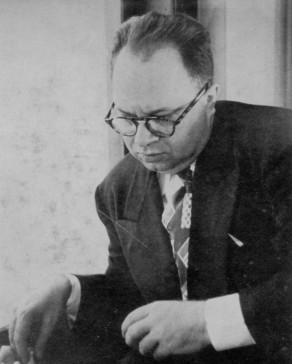
Fred Reinfeld
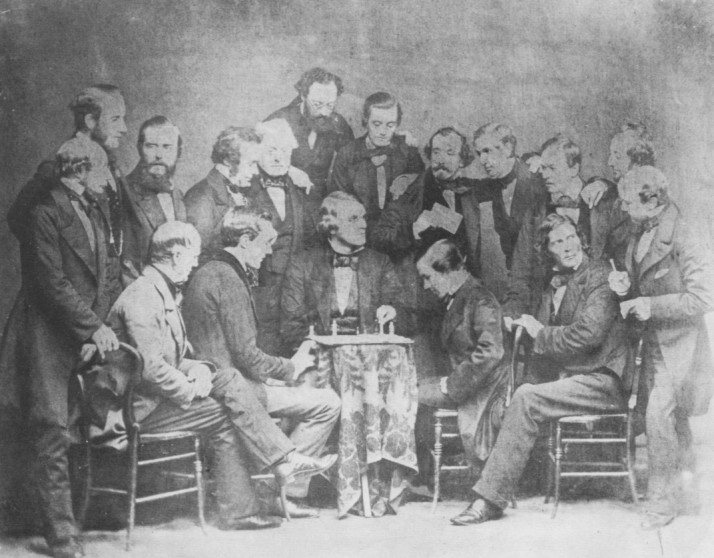
C.N. 1879 referred to page 27 of Fred Wilson’s A Picture History of Chess (New York, 1981), which had this ‘rare photograph of Morphy making a move against Louis Paulsen during the First American Chess Congress (New York, 1857)’. Noting that the other 15 people were not identified, we invited help in building up a complete key (not least because we wondered whether F.M. Edge might be featured). In C.N. 1908 three readers made proposals, which are reproduced below.
From G.H. Diggle:
‘In Lawson’s Paul Morphy, pages 56-57, the group is framed by a “round the clock” set of small portraits representing the 16 competitors at New York, 1857, with two “extras” thrown in (Colonel Mead and George Hammond). On comparing the group with the portraits (after using a magnifying glass to decipher the names under the latter) my own conclusions are:
Standing left to right: Perrin, Lichtenhein, Fuller, Stanley, Thompson, Raphael, Fiske, Mead, Hammond, Montgomery, Knott, Unknown (bald-headed).
Seated left to right: Unknown, Paulsen, Meek, Morphy, Unknown.
Can one of the three “Unknowns” be Edge? He was 27 at the time, and two of them look too old for him; but the man sitting behind Morphy is a possibility.’
A slightly different key was offered by Robert Meadley:
‘Standing left to right: Perrin, Lichtenhein, Fuller, Unknown, Thompson, Raphael, Fiske, Mead, Stanley, Marache, Hammond, Knott.
Seated left to right: Allison, Paulsen, Meek, Morphy, Kennicott.
Clearly Calthrop, who has a very bushy beard and moustache, is missing from the group photograph.
It is also interesting to see how much to-ing and fro-ing went on before the 16 players were selected. Mead didn’t play, yet his photo was there as a player; so also was Hammond’s. Mead was an umpire and Hammond Vice-President of the Congress Committee. Calthrop dropped in very late and Denis Julien dropped out to let Calthrop play. I really think that the one unknown in my “guestimate” of who those players are is Julien, or possibly the Reverend Dr Walton or Lewis Elkin, who were on the Committee of Management. I don’t believe it could possibly be Edge. Actually, I did think it might have been Edge, as the engraving shows the unknown fourth from the left standing as a young man, but the photo shows a not so young man. Edge just wasn’t “high-powered” enough to get in the photo.’
Kenneth Whyld wrote:
‘The photograph was used for an engraving which appears on page 56 of Lawson’s Morphy book. There the group is surrounded by individual engravings of 18 players, which help identification. Numbering the players from left to right, standing 1-12, seated 13-17, I attach these names: 1 Perrin, 2 Lichtenhein, 3 Fuller, 4 Stanley, 5 Thompson, 6 Raphael, 7 Fiske, 8 Mead, 9 ?, 10 Marache, 11 Knott, 12 ?, 13 Allison, 14 Paulsen, 15 Meek, 16 Morphy, 17 Kennicott. Number 9 on the photograph looks quite different from 9 on the engraving, where it could be Hammond. Two of the individual portraits do not appear to be in the group. They are Montgomery and Calthrop. If anyone is Edge it can only be number 12, and he is indeed poised pencil in hand, like a good tournament assistant secretary. However, we should not get too carried away as there were three other assistant secretaries and two marshals, but from what we know of Edge it would be characteristic for him to get into the group.’
We have been looking into this matter again, and not least with the aid of ten sketches of chess figures published on page 345 of Frank Leslie’s Illustrated Newspaper, 31 October 1857, but without resolving any of the outstanding points. As regards Edge, the following extract from his letter of 25 March 1859 to Fiske (given in full in C.N. 1358) may be recalled:
‘I write in the first person but will not affix my name, because I wish Morphy alone to have the glory of his own acts. This has been a rule with me since his arrival in Europe, and though fiercely pressed even by ladies to sit for a photograph with him, I have always refused for I will not have it said that I had any personal motive in sticking by him.’
Whether Edge’s attitude to being photographed had been the same for a group picture in 1857 is an open question.
From page 158 of CHESS, April 1940 (in a review of Reinfeld’s book Practical End-Game Play):
‘Mr Reinfeld is an attractive and industrious writer but there are certain faults of which he must rid himself to become a great one. It is in all kindness that we enumerate them. The first is bumptiousness. He is too prone to throw his weight about from the safe retreat of armchair analysis. The amateur reader, hearing him denounce Tarrasch for “gross blunders”, Schlechter for “superficial appraising of the position”, Euwe for “grossly miscalculating”, Tartakower for “lack of insight” and so forth can hardly fail to ask, with initial admiration: “Who is this genius who can pierce through the armour of the great?” Mr Reinfeld’s playing record comes as a shock. The discovery of occasional “gross errors” in his writings, committed not under the nervous tension of tournament play but in the calm of literary composition and overlooked in successive proof-corrections and the realization that the analysis on which he bases his denunciations is rarely his own (as his own meticulous acknowledgments reveal) add to the disillusionment. Such a disillusionment is unnecessary and pointless. We judge a writer as a writer, a player as a player – until the writer obtrudes his own personality on us by such harsh and pointless criticisms.’
This passage brings to mind criticism of Tarrasch by Irving Chernev, on the inside front cover of the January 1956 Chess Review:
‘Mistakes? Rarely did he make one. But here he pulls a boner that is surely the grandmother of all the blunders ever perpetrated on a chessboard.
List to this tale of woe:
It was in the days of his youth, when all the world was still playing wild gambits. Tarrasch had given a piece for a speculative attack, and his opponent was having a rough time of it. The position had been simplified by an exchange of queens, but the defense was still in trouble. Then, to add to the confusion, Tarrasch sacrificed a bishop. In return, he threatened a tremendous discovered check. It was just a matter of moving his knight to the right square.
But now comes a strange spectacle: that of the great master floundering around, trying to [find] the one discovered check which wins. Tarrasch missed the right idea – not once, but four times in succession. His knight hopped about from square to square and when, at long last, Tarrasch succeeded in winning the game it was with the wrong discovered check.’
The game-score was then given:
Siegbert Tarrasch – Hermann Hirschler1 e4 e5 2 f4 exf4 3 Nf3 g5 4 h4 g4 5 Ne5 d6 6 Nxf7 Kxf7 7 Bc4+ Kg6 8 d4 Be7 9 Bxf4 Nf6 10 h5+ Kg7 11 Nc3 Nc6 12 e5 dxe5 13 h6+ Kf8 14 dxe5 Qxd1+ 15 Rxd1 Nd7 16 O-O Ke8 17 Nd5 Bc5+ 18 Kh1 Bb6 19 e6 Nde5 20 Nf6+ Ke7 21 Bg5 Nxc4

(Chernev: ‘At this point Tarrasch has a win. He pointed it out clearly and concisely long after the game was played [i.e. mate in four with 22 Nh5+]. Tarrasch did not admit that he overlooked the win. Instead, he said that he wanted to confuse his opponent psychologically. He would demonstrate by several knight maneuvers that Black dare not capture the e-pawn and then, when he was thoroughly convinced, Tarrasch would swindle him, playing a variation in which Black must take the pawn to save himself – but is too scared to do so.’) 22 Nxg4+ Ke8 23 Nf6+ Ke7 24 Nd5+ Ke8 25 Nf6+ Ke7 26 Nd7+ Ke8 27 Nf6+ Ke7 28 Ng8+ Ke8 (Chernev: ‘And here indeed Black can save himself by taking the pawn: White has no plausible, winning line.’) 29 Rd8+ Nxd8 30 Rf8+ Kxf8 31 e7+ Resigns.
Chernev’s annotations were based on Tarrasch’s own remarks on pages 391-392 of Dreihundert Schachpartien (Gouda, 1925). See also pages 340-341 of Tarrasch’s Best Games of Chess by F. Reinfeld (London, 1947).
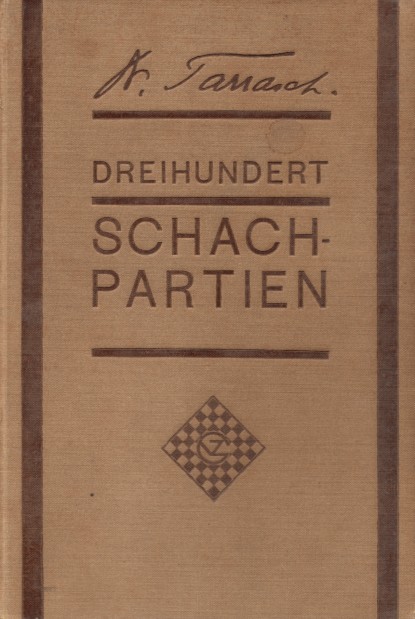
Whether the game was more than an offhand encounter is unclear, but it seems to us a sizeable exaggeration by Chernev to accuse Tarrasch of perpetrating ‘a boner that is surely the grandmother of all the blunders ever perpetrated on a chessboard’.
As regards the occasion, Chernev, who put ‘Nuremberg, 1894’, said that the game was won by Tarrasch ‘in the days of his youth’, whereas he was about 32 at the time. Some databases unaccountably state that the game was played in Berlin in 1880.
‘Capablanca’s Boner’ is the gleeful caption to a diagram on page 26 of Great Chess Books of the Twentieth Century in English by Alex Dunne (Jefferson, 2005). It concerns this well-known position discussed by the Cuban in Chess Fundamentals:

However, Mr Dunne shows himself oblivious of the complexities set out on pages 319-320 of Kings, Commoners and Knaves. In the same section of his book (page 25) he also goes awry on the elementary matter of the proportion of Capablanca’s losses given in Chess Fundamentals, and on page 27 he misspells (i.e. miscopies from pages 332-333 of A Chess Omnibus) the name of the person spuriously indicated as the author of the first pirated Coles edition of Chess Fundamentals. This sequence of ‘Dunne’s Boners’ comes from the single Chess Fundamentals section in Great Chess Books, and the rest is no better. The most forbearing observation about Mr Dunne’s work is that The Literature of Chess by John Graham, a similar volume published by the same company (McFarland) in 1984, was even worse, but that is faint praise indeed.
From Jack O’Keefe (Ann Arbor, MI, USA):
‘The Kashdan problem in C.N. 3790 was originally published (with one small difference) in Chess Review of June 1933, page 28, and was reprinted in the Times Literary Supplement of 20 July 1933, page 500. In the original there was a black pawn on c5, rather than a white pawn on a4.’
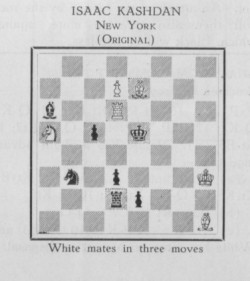
Chess Review, 1933
John Hilbert (Amherst, NY, USA) writes:
‘Albert B. Hodges and Mordecai Morgan, both accomplished over-the-board players, contested two correspondence games in the New York v Pennsylvania correspondence match, both games ending in late January 1902. According to the 2 February 1902 Brooklyn Daily Eagle, “The notable event of the week is the conclusion of the two games between A.B. Hodges and Mordecai Morgan. The latter scored first blood by outwitting the ex-champion in a finely played Ruy López, but immediately upon receiving Hodges’ capitulation returned the compliment by resigning a Queen’s Gambit Declined. This was handled by Hodges in a beautiful manner and is as fine a specimen of correspondence chess as has appeared in some time. The score:”
Helms then gave the following game as “Game A” between the players:
Albert Beauregard Hodges – Mordecai Morgan
New York v Pennsylvania Correspondence Match, Game A, 1902
Queen’s Gambit Declined1 d4 d5 2 c4 e6 3 Nc3 Nf6 4 Bg5 Nbd7 5 cxd5 exd5 6 e3 c6 7 Bd3 Qa5 8 Nge2 Bd6 9 O-O O-O 10 Ng3 h6 11 Bh4 Qc7 12 Rc1 a6 13 Nh5 Qd8 14 Bb1 Be7 15 Qd3 g6 16 Nf4 Qe8 17 Rfe1 Bb4 18 f3 Bxc3 19 bxc3 g5 20 e4 dxe4 21 fxe4 Ne5 22 dxe5 Qxe5 23 Bf2 Ng4 24 Bd4 Resigns.
The February 1902 issue of American Chess World, page 36, gives the same game score, Game No. 139, as Hodges v Morgan, but, curiously, according to the heading the game was allegedly played in the Franklin Chess Club (Philadelphia) championship tournament. In addition, the annotations, which are referenced to the game through the use of letters of the alphabet within parentheses, following the appropriate move, indicate the game ends with an (i) note, while the annotations end after (h).
The second game appearing on the same American Chess World page, on the other hand, Game No. 140, is offered as played between C.J. Newman and Mordecai Morgan in the New York v Pennsylvania correspondence match. As printed this game ends its annotations with an (h) note, while the notes themselves, trailing over to page 37, end with (i).
I note that both C.J. Newman and Morgan were well-known Philadelphia-based players, and both played in numerous Franklin Chess Club championship events. They hardly would have been paired in the New York v Pennsylvania correspondence match. Hodges, on the other hand, was New York-based, never was a member of the Franklin, and so never would have played in any of that club’s championship events. These facts, coupled with the annotations obviously being meant each for the other game, indicate a mix-up in game headers, scores and annotations has taken place.
Sure enough, page 65 of American Chess World, March 1902, under “Errata”, indicates “The scores of games No. 139 and 140 should be transposed”.
But is that the case? If “the scores of games No. 139 and 140 should be transposed” (emphasis added), then we find the following game appearing as the game score supposedly played by Hodges and Morgan by correspondence:
1 d4 d5 2 Nf3 e6 3 c4 Nf6 4 Nc3 c5 5 cxd5 exd5 6 Bg5 Be7 7 dxc5 Be6 8 e3 Bxc5 9 Bb5+ Nc6 10 Ne5 Rc8 11 Qa4 Qb6 12 O-O Be7 13 Rad1 a6 14 Bxc6+ bxc6 15 Bxf6 Bxf6 16 Nxd5 Qxb2 17 Nxf6+ gxf6 18 Nxc6 Qxa2 19 Qd4 Resigns.
It would appear likely that what the March 1902 American Chess World errata should have said was that the annotations for the games had been transposed, as well as the venue of play, but that the opponents and actual game scores should remain as they are. Errata errata, so to speak.
Does anyone have evidence to the contrary? Do any other sources give the second game, above, as in fact Game A of the two correspondence games Hodges and Morgan contested in the interstate match? I would appreciate learning of other sources for Game A of the Hodges v Mordecai Morgan interstate match, whichever game score is given.
For sake of completeness, I offer the score for Game B between the two players, the “finely played Ruy López” Helms mentioned above, which appeared in multiple sources without confusion:
Mordecai Morgan – Albert Beauregard Hodges
New York vs. Pennsylvania Correspondence Match, Game B, 1902
Ruy López1 e4 e5 2 Nf3 Nc6 3 Bb5 a6 4 Ba4 Nf6 5 O-O d6 6 d4 Nd7 7 dxe5 Ncxe5 8 Nxe5 dxe5 9 Qh5 Bd6 10 Bg5 Be7 11 Be3 O-O 12 Nc3 c6 13 Bb3 Bf6 14 Rad1 Qe7 15 f4 exf4 16 Bxf4 g6 17 Qf3 Ne5 18 Qg3 b5 19 Rd2 Ra7 20 Bh6 Re8 21 Rdf2 Bh8 22 Bf4 Qf8 23 Qe3 Ree7 24 Bxe5 Resigns.
Sources: Brooklyn Daily Eagle, 23 February 1902; The Literary Digest (New York), 1 February 1902; North American, 9 February 1902.’
From Hans Kmoch’s obituary of Tartakower on pages 123-125 of Chess Review, April 1956:
‘Few people knew how much he liked poetry – poetry in all the three languages of which he had perfect command: Russian, German and French, to say nothing of Latin and Greek. Translating poems was his secret hobby.’
In the above-mentioned obituary in Chess Review the ‘Altmeister’ Adolf Zinkl was described by Kmoch as ‘a friendly man remarkable mainly for his looking 40 at 70’. We have not yet found a photograph of Zinkl in his old age or, indeed, a report of his death. A feature on pages 183-185 of the June 1931 Wiener Schachzeitung announced that he had celebrated his 60th birthday on 10 June 1931.
A group photograph from San Remo, 1930 is seldom seen, and we have yet to find a good-quality copy. The one below was published on page 42 of El Ajedrez Americano, February 1930:
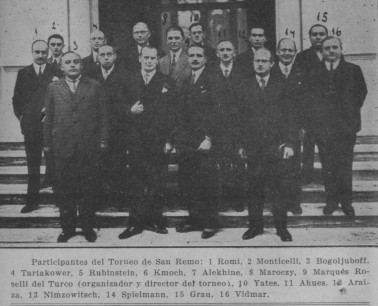
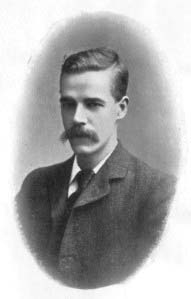
Henry Ernest Atkins
H.E. Atkins wrote little about chess, but below is a brief example of his prose, written in December 1911 and included in the Introduction to the first three editions of Modern Chess Openings by R.C. Griffith and J.H. White:
‘Few players as a rule get the advantage that they might do from bookwork, and the reason is that the work is not done thoroughly enough, the moves are played over and learnt by heart, without being properly appreciated. Every move should be gone into and the reason found out; in fact it is hardly an exaggeration to say that the slower the variations are gone over the better. It undoubtedly requires great patience and perseverance to go through openings in the way suggested, but the result fully justifies the trouble. In ordinary practice games it is very rare for much trouble to be taken over the opening part of a game; players do not really try to find the best possible move as long as they can find an apparently fairly good one, and accordingly very little improvement is made in opening strategy.
Clocks should be used more than is the case at present. In most clubs they are only forthcoming when matches are taking place, and players feeling that the state of things is unusual become nervous and fail to do themselves justice.
It would too, I think, be a useful thing if players occasionally would agree on a series of games where play was to stop after each had made 20 moves.
Such games would be excellent practice for match chess. They would take up comparatively little time, and would, I think, lead to great improvement.
Openings like the Ruy López and QP Opening are exceedingly difficult to play well, and are not suited to the inexperienced player. The principles involved are too difficult to be properly understood, and the mere learning off of the moves is of little good from an instructive point of view.
Openings of a more decisive character, such as the King’s Gambit, Vienna, Scotch, Danish Gambit, and so forth, are of much greater value.’

We are still seeking information about the interest of Lord Alfred Douglas (1870-1945) in chess. Page 397 of A Chess Omnibus quoted the following paragraph by Marie Stopes about her contact (circa 1939) with him:
‘We played chess and he played just the way I do enjoy it, very rapid moves, and we were very level in sets of three, I winning two out of three in one set, and in another set he winning two out of three.’
Source: Marie Stopes A Biography by K. Briant (London, 1962), pages 204-205.
Below from our collection is a book inscription by Douglas to Hesketh Pearson, whose own writings included a biography of Oscar Wilde:

Avital Pilpel (New York) informs us of the following remarks by Bruce Pandolfini in his column of 22 June 2005 at the Chess Café:
Our article Napoleon Bonaparte and Chess focussed on facts and quotes, but a windier approach is favoured in Napoléon Joueur d’Echecs by Thierry Libaert. The final paragraph, in particular, ascends to at least a nine on the Beaufort scale:
‘En somme, et sans qu’il soit possible d’en tirer un quelconque scénario de causalité, la défaite napoléonienne a marqué une rupture tout à la fois dans les conceptions militaires que théorisera Clausewitz et dans les conceptions échiquéennes que développera Steinitz. L’influence de Napoléon sur le jeu d’échecs est de ce point de vue considérable, elle tient toutefois davantage aux évolutions de la culture stratégique globale qu’aux parties qu’il aurait personnellement jouées.’
Below are two games by the prodigy which are not in Stephen W. Gordon’s ‘complete games’ collection Samuel Reshevsky (Jefferson, 1997):
Samuel Herman Reshevsky – C. Degraeve1 e4 e5 2 f4 Bc5 3 Nf3 d6 4 Bc4 Nc6 5 c3 Nf6 6 d4 exd4 7 cxd4 Bb4+ 8 Bd2 Bxd2+ 9 Nbxd2 O-O 10 d5 Ne7 11 O-O c6 12 dxc6 bxc6 13 Qc2 d5 14 exd5 Bf5 15 Qc3 Nexd5 16 Qd4 Qb6 17 Qxb6 axb6 18 Nd4 Bd7 19 Bb3 Rfe8 20 g3 c5 21 N4f3 Bc6 22 Ne5 Bb7 23 Ndc4 Re7 24 Rfe1 b5 25 Nd6 c4 26 Bd1 Ba6 27 Bf3 Rd8 28 Nf5 Ree8 29 Rad1 Bb7
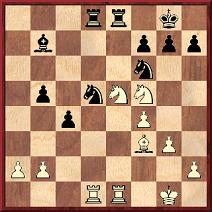
30 a4 bxa4 31 Nxc4 Rxe1+ 32 Rxe1 Bc8 33 Nfd6 Ba6 34 Rc1 Bxc4 35 Nxc4 Rc8 36 Rc2 Nb6 37 Na3 Rxc2 38 Nxc2 Nc4 39 Kf2 Nxb2 40 Ke2 Nc4 41 Kd3 Nb6 42 Kd4 Kf8 43 Kc5 Nfd7+ 44 Kb4 Ke7 45 Nd4 g6 46 Bc6 f5 47 Bxa4 Nxa4 48 Kxa4 Kd6 49 Kb5 Nf6 50 Nf3 Ne4 51 Kc4 Kc6 52 Kd4 Kd6 53 g4 Ke6 54 h3 Kd6 55 Nh4 Ke6 56 Ng2 Kd6 57 Ne3 Ke6 Drawn.
Source: La Stratégie, June 1920, pages 122-123.
Samuel Herman Reshevsky – M. Billoret1 e4 e6 2 d4 d5 3 e5 c5 4 c3 Nc6 5 Nf3 Nge7 6 Bd3 Ng6 7 O-O cxd4 8 cxd4 Be7 9 a3 O-O 10 g3 Qe8 11 h4 f6 12 Re1 f5 13 Kg2 f4 14 h5 Nh8 15 Bxf4 Rxf4 16 gxf4 Qxh5 17 Rh1 Qg4+ 18 Kf1 Ng6 19 Nc3 Bd7 20 Bxg6 Qxg6 21 Ne2 Qg4 22 Qd3 h6 23 Rg1 Qh3+ 24 Ke1 Rf8 25 Kd2
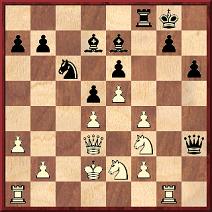
25...Bg5 26 Nxg5 Qxd3+ 27 Kxd3 hxg5 28 Rxg5 Ne7 29 Rag1 Nf5 30 Ng3 Nxg3 31 fxg3 Bb5+ 32 Kd2 Rc8 33 Rc1 Rf8 34 Rc7 Rf7 35 Rxf7 Kxf7 36 f5 Bd7 37 fxe6+ Bxe6 38 Rh5 Kg8 39 Rh1 Bd7 40 Rc1 Bc6 41 b4 Kf7 42 b5 Resigns.
Source: La Stratégie, June 1920, page 126.
A third game from the French magazine, against L. Schwarz, was
given in C.N. 2472 (see page 98 of A Chess Omnibus).
However, that earlier item was incorrect to say that a fourth
game in La Stratégie (a 70-move win against A. Silbert)
was absent from Stephen W. Gordon’s book. We also add here that
page 121 of the June 1920 issue of La Stratégie reported
that on 20 June Reshevsky had played 14 lightning games (lasting
an average of two minutes each) against E. Antoniadi, winning
with a score of +12 –1 =1.
Still on the subject of Reshevsky, the photograph below, taken at the Hotel Breslin, New York on 27 February 1922, was published on page 44 of the March 1922 American Chess Bulletin:

The caption states, ‘William F. Drueke of Grand Rapids is shown in the center and the sturdy back of Referee Katz is very much in evidence’. Having referred to two chess books by Drueke in C.N. 3738, we should welcome biographical information about him.
Maurice Carter (Fairborn, OH, USA) mentions that a rather better copy of the San Remo, 1930 photograph was published on page 163 of Alt om Skak by B. Nielsen (Odense, 1943):

We are hopeful that a reader can help us find out more about an incident reported in C.N. 790 (see pages 119-120 and 263 of Chess Explorations), i.e. the claim that shortly before the Vienna, 1922 tournament Alekhine tried to kill himself.
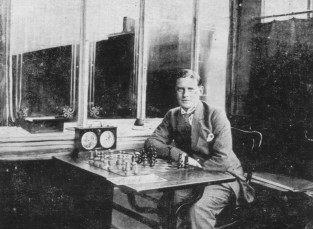
Alexander Alekhine
On 27 June 1984 James J. Barrett (Buffalo, NY, USA) wrote to us:
‘Did you know that Alekhine once plunged a knife into his abdomen while in a hotel lobby, in the presence of his friend Edmond Lancel? I have never seen a reference to this episode in all the Alekhine material I have read.’
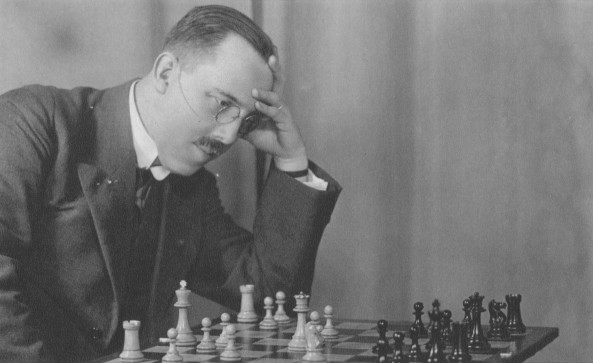
Edmond Lancel
Mr Barrett subsequently provided particulars, i.e. an extract from Lancel’s article about Alekhine on pages 1152-1153 of the April 1946 issue of L’Echiquier Belge. Below is the relevant passage, in our translation:
‘Alekhine took a few days off to rest in Aachen, where I was staying. Since the beginning of the year, we had been together on several occasions. We spent the evening of his birthday together at the Hotel Corneliusbad. He confided in me, talked to me about his life and showed me pictures of people close to him. We played, as we often did, several training games in preparation for the important Vienna tournament, which was to take place from 13 November to 2 December. Around three o’clock in the morning, without any warning whatsoever, in the grand hall of the hotel which was deserted except for my partner and myself, Alekhine suddenly tried to commit suicide in a moment of despair by stabbing himself in the stomach, and fell unconscious at my feet. I alerted the people at the hotel; the director, doctor, ambulance and police were summoned. The situation appeared extremely serious, and Alekhine did not regain consciousness. However, thanks to the rapid and energetic intervention of those called, he came around and a few days later he had recovered. Nonetheless, this incident was significant, occurring as it did shortly before the Vienna tournament. I did my best to dissuade my old friend from participating, for I was sure that he would not do well. My efforts were in vain; he insisted on playing ...’
A chess prodigy seldom mentioned nowadays is Enrique Reed Valenzuela (1915-58) of Chile, who won his country’s championship in 1932. His earliest game known to us is a 50-move loss against Alekhine in a simultaneous exhibition in Santiago on 27 December 1927. The game-score was given on pages 7-8 of Alekhine in Europe and Asia by J. Donaldson, N. Minev and Y. Seirawan (Seattle, 1993), which quoted Alekhine’s remark at the time: ‘Enrique Reed also is a promising youngster, and he showed an excellent temperament’. Alekhine gave him further praise when annotating the game Reed v Danielsson, Buenos Aires, 1939 on pages 73-75 of Gran Ajedrez (Madrid, 1947):
‘One of the very few revelations of the 1939 Buenos Aires Olympiad was Ernst [sic] Reed, the young Chilean (of Germany ancestry) whose style was distinguished by its clear energy and daring attacking conception.’

Enrique Reed Valenzuela
The May-June 1932 issue of L’Echiquier had the above portrait, as well as, on pages 1747-1748, four of his games from the 1932 national championship:
Enrique Reed Valenzuela – N.N.1 d4 Nf6 2 Nf3 e6 3 c4 Bb4+ 4 Bd2 Qe7 5 Nc3 b6 6 e3 Bb7 7 Bd3 Bxc3 8 Bxc3 Ne4 9 Qc2 Nxc3 10 Qxc3 a5 11 Nd2 Na6 12 O-O-O Nb4 13 Bb1 f5 14 a3 Na6 15 f3 O-O-O 16 Rhe1 Kb8 17 Bd3 c5 18 d5 Qf6 19 Qb3 Ka7 20 Nb1 g6 21 Nc3 Nc7 22 d6 Na8 23 Rd2 Bc6 24 Kc2 Rb8 25 Qa2 Qd8 26 b4 cxb4 27 axb4 Rf8 28 Ra1 Rh8 29 Qb1 Bb7 30 Nb5+ Ka6
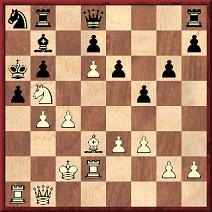
31 bxa5 bxa5 32 Nc7+ Nxc7 33 c5+ Nb5 34 Qxb5+ Resigns.
Renato Barbagelata – Enrique Reed Valenzuela1 c4 Nf6 2 Nc3 e6 3 e4 d5 4 exd5 exd5 5 d4 c6 6 Nf3 Bg4 7 Bd3 Be7 8 Be3 O-O 9 O-O Re8 10 Qb3 Bxf3 11 gxf3 Qd7 12 Bf4 Nh5 13 Bg3 Bf6 14 Rad1 Rd8 15 Rfe1 g6 16 cxd5 cxd5 17 Bf1 Nc6 18 Ne2 Re8 19 Qd3 Re7 20 Rc1 Rae8 21 Qd2 Qf5 22 f4 Ng7 23 f3 h5 24 h4 Ne6 25 Bf2 Nexd4 26 Nxd4 Nxd4 27 Bg2 Ne2+ 28 Kh2 Nxc1 29 Rxe7 Bxe7 30 Qxc1 Bd6 31 Kg3 Re2 and Black won in a few moves.
Mariano Castillo Larenas – Enrique Reed Valenzuela1 d4 Nf6 2 Nf3 e6 3 c4 b6 4 g3 Bb7 5 Bg2 Bb4+ 6 Nbd2 c5 7 O-O
Bxd2 8 Qxd2 O-O 9 Qc2 Be4 10 Qc3 cxd4 11 Nxd4 Bxg2 12 Kxg2 d5 13
Bg5 dxc4 14 Qxc4 Nbd7 15 Nc6 Qe8 16 f3 Rc8 17 Rac1 h6 18 Bxf6 Nxf6
19 e4 Nd7 20 Qa6
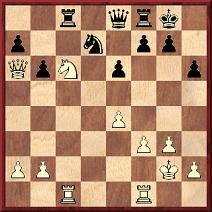
20...Rxc6 27 Qxa7 Rxc1 22 Rxc1 b5 23 Rc7 Nb8 24 Rb7 b4 25 Qb6 Qc8 26 Qxb4 Qc2+ 27 Kh3 Nc6 28 Qc3 Qxc3 29 bxc3 Rc8 30 f4 Na5 31 Rb5 Nc4 32 e5 Ne3 33 Rb3 Nd5 34 a4 Rxc3 35 Rb8+ Kh7 36 Kg2 Ra3 37 Ra8 Kg6 38 a5 Nb6 39 f5+ Kxf5 40 Ra7 Nc4 41 Rxf7+ Kxe5 42 Rxg7 Ne3+ 43 Kf2 Nc4 44 Rg6 Rxa5 45 Rxh6 Ra2+ 46 Kf3 Nd2+ 47 Ke2 Ne4+ 48 Ke3 Ra3+ 49 Ke2 Kd4 50 g4 Ra2+ 51 Kf1 e5 52 h4 Ke3 53 g5 Kf3 54 Kg1 Kg3 55 Kf1 Nc3 56 Ke1 Re2+ 57 Kf1 Rd2 58 White resigns.
N.N. – Enrique Reed Valenzuela1 c4 Nf6 2 Nc3 e6 3 e4 c5 4 e5 Ng8 5 Nf3 Nc6 6 Nb5 d6 7 exd6 Bxd6 8 Nxd6+ Qxd6 9 Be2 Nge7 10 b3 e5 11 d3 O-O 12 O-O Rd8 13 Bb2 Bf5 14 Re1 Ng6 15 Bf1 f6 16 Ba3 b6 17 Re2 Bg4 18 Rd2 Nd4 19 h3 Bxf3 20 gxf3 Nh4 21 Bg2 f5 22 Bh1 Qh6 23 Bc1 Qg5+ 24 Kf1 Qf4 25 Bb2 Qh2 26 Bxd4 exd4 27 White resigns.
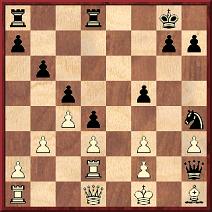
In the 1930s Chile had a number of strong young players; in addition to Enrique Reed, there were, for instance, Rodrigo Flores (born 1913) and René Letelier (born 1915). Some of Flores’ early games were given in C.N. 3046, and now we turn to Letelier (whose name gained in familiarity when a loss to Fischer was included in My 60 Memorable Games).
The photograph below was published on page 335 of El Ajedrez Americano, November-December 1932:
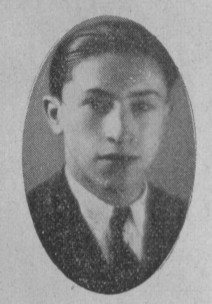
René Letelier Martner
There follow, from the same periodical, seven early games by Letelier:
Mariano Castillo Larenas – René Letelier Martner1 e4 e5 2 Nf3 Nc6 3 Bc4 Bc5 4 c3 Qe7 5 d4 Bb6 6 O-O Nf6 7 Bg5 d6 8 d5 Nb8 9 Nbd2 Bg4 10 Be2 h6 11 Be3 Nbd7 12 a4 g5 13 a5 Bxe3 14 fxe3 Kf8 15 b4 Rg8 16 Kh1 h5 17 Rf2 Bxf3 18 Rxf3 g4 19 Rf5 Rg6 20 Qe1 Kg7 21 Qh4 Nxd5 22 Qxe7 Nxe7 23 Rxh5 Nf6 24 Rh4
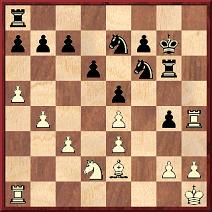
24...Rg5 25 Rf1 Ng6 26 Rxf6 Nxh4 27 Rf2 g3 28 hxg3 Rxg3 29 Nf1 Rh8 30 White resigns.
Source: El Ajedrez Americano, July 1932, page 192.
René Letelier Martner – Eduardo Schütz1 e4 e6 2 Nc3 d5 3 d4 dxe4 4 Nxe4 Nd7 5 Bd3 Ngf6 6 Bg5 Be7 7 Bxf6 Nxf6 8 Nf3 O-O 9 Nxf6+ Bxf6 10 Qe2 Qd5 11 O-O c5 12 c4 Qh5 13 dxc5 e5 14 Be4 Rb8 15 Rfe1 Bg4 16 Qc2 Rfe8 17 Re3 Bd8 18 b4 Bc7 19 Rae1 Rbd8 20 h3 Bc8 21 Bd5 Kh8 22 Qc3 f6 23 Re4 g5

24 Nxe5 fxe5 25 Rxe5 Rxe5 26 Rxe5 Qd1+ 27 Re1+ Resigns.
Source: El Ajedrez Americano, July 1932, page 192.
René Letelier Martner – Juan Cordaro
Santiago, 1932
Queen’s Gambit Declined
1 c4 e6 2 d4 d5 3 Nc3 c6 4 Nf3 Nf6 5 Bg5 Nbd7 6 e3 Be7 7 Qc2 dxc4 8 Bxc4 Nd5 9 Bxe7 Qxe7 10 O-O Nxc3 11 Qxc3 Nf6 12 Rac1 O-O 13 Bb3 Bd7 14 Ne5 Rfc8 15 f4 g6 16 g4 Ne4 17 Qd3 Nd6 18 g5 Kg7 19 e4 Rf8 20 Ng4 Ne8 21 e5 Rh8 22 Qh3 Rc8 23 Nf6
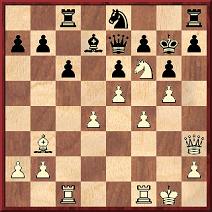
23...h5 24 gxh6+ Rxh6 25 Qxh6+ Kxh6 26 Ng8+ Kg7 27 Nxe7 Rc7 28 f5 gxf5 29 d5 cxd5 30 Rxc7 Nxc7 31 Rc1 Nb5 32 Kf2 f6 33 exf6+ Kxf6 34 Ng8+ Kf7 35 Rg1 Resigns.
Source: El Ajedrez Americano, November-December 1932, page 335.
Eduardo Schütz – René Letelier Martner1 e4 e6 2 d4 d5 3 e5 c5 4 Qg4 Ne7 5 Nf3 Nec6 6 Bd3 Nd7 7 Qg3 Qc7 8 O-O cxd4 9 Re1 Nc5 10 a3 Bd7 11 b4 Nxd3 12 cxd3 Qb6 13 Nbd2 a5 14 Bb2 axb4 15 axb4 Rc8 16 Reb1 g6 17 Qf4 Bg7 18 Ba3 Qb5 19 Nb3 O-O 20 Nbxd4 Nxd4 21 Qxd4 Rc7 22 Bb2 b6 23 Qe3 Rfc8 24 Nd4 Qxb4 25 Ba3 Qc3 26 Bb4

26...Bh6 27 f4 Bxf4 28 Qxf4 Qxd3 29 Rd1 Qe4 30 Qxe4 dxe4 31 Ne2 Bb5 32 Ng3 Bd3 33 Re1 Rc4 34 Bd2 h5 35 Rac1 b5 36 Rxc4 Rxc4 37 Rc1 Rxc1+ 38 Bxc1 f5 39 exf6 Kf7 40 Kf2 h4 41 Nf1 Kxf6 42 Bb2+ Ke7 43 h3 Kd6 44 Nd2 e5 45 Ke3 Kd5 46 Ba3 Bc2 47 Be7 Bd3 48 Bxh4 Bc2 49 Be7 Bd3 50 h4 Ke6 51 Bb4 Kf5 52 Nb3 Kg4 53 Be1 g5 54 g3 gxh4 55 gxh4 Bc2 56 Nc5 b4 Drawn.
Source: El Ajedrez Americano, November-December 1932, pages 335-336.
Mariano Castillo Larenas – René Letelier Martner1 e4 e5 2 d4 exd4 3 Qxd4 Nc6 4 Qa4 Nf6 5 Nc3 Bb4 6 Bd2 Qe7 7 O-O-O a6 8 Nf3 O-O 9 e5 Bxc3 10 Bxc3 Ne8 11 Bd3 f5 12 h4 b5 13 Qf4 b4 14 Bc4+ Kh8 15 Bd4 Bb7 16 Be3 d6 17 exd6 cxd6 18 Ng5 Ne5 19 Bb3 a5 20 h5 h6 21 Nf3 a4 22 Bd5 Bxd5 23 Rxd5 Nf6 24 Rxe5 dxe5 25 Nxe5 Qe6 26 Ng6+ Kg8 27 Nxf8
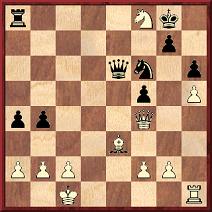
27...Qxa2 28 Nd7 Ne4 29 Kd1 Qd5+ 30 Ke2 Qxd7 31 Rd1 Qb5+ 32 Ke1 Rc8 33 g4 Rxc2 34 Rd8+ Kh7 35 Qxf5+ Qxf5 36 gxf5 Rxb2 37 Rd4 a3 38 White resigns.
Source: El Ajedrez Americano, November-December 1932,
page 336.
1 e4 e6 2 d4 d5 3 exd5 exd5 4 Bd3 Nc6 5 c3 Bd6 6 Ne2 Qf6 7 O-O Nge7 8 Be3 Bf5 9 Bxf5 Nxf5 10 Qb3 O-O-O 11 Bd2 Rhe8 12 Ng3 h5 13 Qc2 g6 14 Na3 h4 15 Nh1
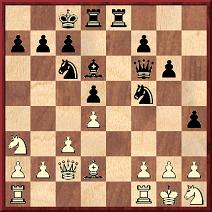
15...Ncxd4 16 cxd4 Nxd4 17 Bc3 Qf4 18 g3 Nf3+ 19 White resigns.
Source: El Ajedrez Americano, September 1933, pages 230-231.
Araya – René Letelier Martner1 d4 e6 2 c4 f5 3 Nf3 Nf6 4 Bg5 Bb4+ 5 Nc3 O-O 6 a3 Bxc3+ 7 bxc3 d6 8 e3 Nbd7 9 Qc2 h6 10 Bxf6 Qxf6 11 Be2 e5 12 e4 g5 13 O-O f4 14 h3 h5 15 Rad1 Kh8 16 Nh2 Qg6 17 Bf3 Nf6 18 Rde1 g4 19 hxg4 hxg4 20 Bd1 g3 21 fxg3 fxg3 22 Nf3 Qh5 23 Qd2 Rg8 24 Re3 Rg7 25 Rfe1 Bg4 26 Kf1 Qh1+ 27 Ng1 Rf8 28 Rf3 Bxf3 29 Bxf3 Rgf7 30 Qd3 Nh5 31 Re3 Nf4 32 Qd2
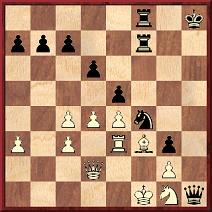
32...Nh3 33 gxh3 Rxf3+ 34 Rxf3 Rxf3+ 35 White resigns.
Source: El Ajedrez Americano, December 1933, pages 318-319.

Page 98 of the 5/2005 New in Chess has the following exchange with Ruslan Ponomariov:
‘What is the best chess game you ever saw?’
‘Spielmann-Stoltz, Stockholm 1930, 5th game of the match.’
Ponomariov’s interesting choice prompts us to offer some jottings on this famous game, given here for ease of reference: 1 e4 e6 2 d4 d5 3 Nd2 Nf6 4 e5 Nfd7 5 Bd3 c5 6 c3 Nc6 7 Ne2 Qb6 8 Nf3 cxd4 9 cxd4 Bb4+ 10 Kf1 f6! 11 Nf4 fxe5 12 Nxe6 e4 13 Bf4
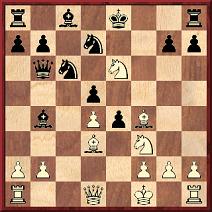
13...exf3!! 14 Bc7 Nf6 15 Nxg7+ Kf7 16 Bxb6 Bg4 17 g3? Bh3+ 18 Kg1 Kxg7 19 Bc7 Rhe8 20 Be5 Nxe5 21 dxe5 Rxe5 22 Qb3 Bc5! 23 Bf5 Bxf5 24 Qxb7+ Kg6 25 Qxa8 Re2 26 h4 Bxf2+ 27 Kf1 Be3 28 h5+ Kg5 29 White resigns.
Spielmann won the match +3 –2 =1, despite succumbing in the above brilliancy, which he annotated in the Münchner Zeitung. [See the correction in C.N. 4524.] Those notes were reproduced on pages 375-377 of the December 1930 Deutsche Schachzeitung, and his punctuation has been included in the game-score above. He called the encounter reminiscent of the Immortal Game, adding that he was still not altogether sure where he had made his decisive mistake and whether he already had a lost game after winning his opponent’s queen:
‘Eine Partie, die wie ein Märchen aus längst verklungenen Zeiten anmutet und an die unsterbliche Partie Anderssen-Kieseritzky erinnert. Wo aber habe ich eigentlich den entscheidenden Fehlzug gemacht? War meine Partie nach dem Damengewinn schon verloren? Diese Fragen kann ich bis heute nicht restlos beantworten und man sieht wieder, wie unergründlich tief und rätselvoll das Schachspiel trotz aller Fortschritte geblieben ist.’
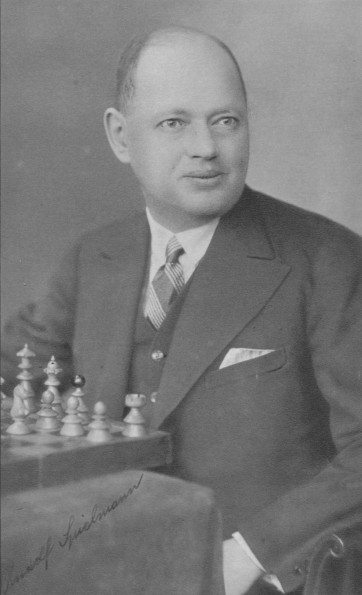
Rudolf Spielmann
Annotating the game on pages 86-87 of the February 1931 BCM J.H. Blake commented:
‘Spielmann generously says in his column in the Münchner Zeitung that his opponent’s conduct of this game reminds him of Anderssen’s “Immortal Game”; but this will be considered in some quarters as extravagant. In view of the course of the game a juster comparison would be with the great 50th game between Labourdonnais and McDonnell, in which the latter on his 13th move sacrificed his queen for two minor pieces and won on the 36th move.’
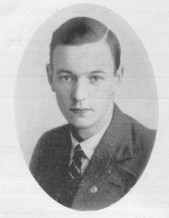
Gösta Stoltz
Tidskrift för Schack (December 1930, pages 273-274) gave the Spielmann v Stoltz game with a Swedish translation of Spielmann’s notes, and fairly detailed annotations by E.E. Böök appeared in his two monographs on the victor, i.e. on pages 40-42 of Schackmästaren Gösta Stoltz (Stockholm, 1947) and on pages 30-32 of Stormästaren Gösta Stoltz (Stockholm, 1968). We have yet to ascertain whether Stoltz himself annotated the game anywhere.
Jonathan Hinton (East Horsley, England) draws attention to the following passage by P.H. Clarke in his ‘From the USSR’ column on pages 117-118 of the April 1963 BCM:
‘Chess in 2000
Will the world champion in 2000 be a man or a machine? This was the subject for discussion on Moscow television recently by grandmasters Smyslov, Bronstein and Averbakh. As might be expected, no agreement was reached. Averbakh held that in about 35 years’ time scientists will be able to design a machine perfect enough to compete with masters and even grandmasters and that it will have many advantages over man. Smyslov was of a different opinion. He compared chess with music, asserting that just as a mechanical composer could not rival human fantasy, so a machine could not play better chess than a man.
Bronstein took a middle line, surmizing that by the year 2000 there would be separate championships for men and machines. I wonder who will be right.’
On page 130 of the May 1951 Chess Review a reader, E. Gram-Larsen of Solar, Norway, wrote regarding a Lasker v Steinitz ending:
‘In the 14th game of the second world championship match, the following position occurred after Black’s 52nd move:
There followed 53 Rc2?? Rxc2+ 54 Kxc2 and Black resigned after White’s 78th move. But if Black had played 53...Ra1+ White might have resigned as his rook on d1 is lost. It could have been Emanuel Lasker’s greatest blunder.
I have the game from Ludwig Bachmann’s book Schachmeister Steinitz, Vol. 4, Ed. 1921. It was played on 29 December 1896. I thought there might be errors in the score – there are many in other places in the book – but, so far as I can see, the moves leading to the above position are in order.’
We believe, however, that Bachmann erred by putting as White’s 50th move Rd6-d1, rather than Rd6-d8, and that there was thus no blunder by Lasker at move 53.

Position after 49...Kd4-c5
Although 50 Rd1 was also given in the Weltgeschichte des Schachs volume on Steinitz by David Hooper (Hamburg, 1968) and the two editions of Chess World Championships by James H. Gelo (Jefferson, 1988 and 1999), all contemporary magazines verified by us so far have 50 Rd8. Examples are Deutsches Wochenschach, 10 January 1897, pages 6-7 and Deutsche Schachzeitung, February 1897, pages 38-40.
From Calle Erlandsson (Lund, Sweden):
‘I have never seen the Spielmann v Stoltz game annotated by Stoltz himself. Eero E. Böök’s remark on 1...e6 was: “According to Stoltz this was the first time he played the French
Defence in a tournament [sic] game.” Some of Böök’s other comments in Schackmästaren Gösta Stoltz (Stockholm, 1947) are of interest:
3...Nf6: “After the game the move was considered finally refuted. This is correct, but the evidence submitted is wrong, as we shall soon see.”
12...e4!?: “In reality a decisive mistake! Nine years after this game was played Keres proved that Black obtains a superior game after the surprising pawn sacrifice 12...Nf6! The idea is rather simple, a real Columbus egg, but it is strange that nobody thought of the move, despite this elegant game having been published in all chess magazines and columns all over the world.”
In the second edition (Stockholm, 1968) Böök’s annotations were different:
3...Nf6 No comments ...
12...e4!: “Nor can Black save the game with 12...Nf6!?, which was mentioned by Keres as a refutation. In the game Vasilchuk v Chinarev, Moscow, 1962 White obtained a decisive advantage after 12...Nf6!? 13 Nxg7+ Kf8! 14 Bh6 Kg8 15 Qc1! Ng4 16 Nh5 (16 Nf5! is even stronger.) 16...Be7 17 h3 Nb4 18 hxg4 Nxd3 19 Qd2, etc. Stoltz’s move in the game, for a long time considered wrong owing to Keres’s ‘refutation’, is a brave try to save a seemingly hopeless game.”’
Mr Calle Erlandsson has sent us this postcard:
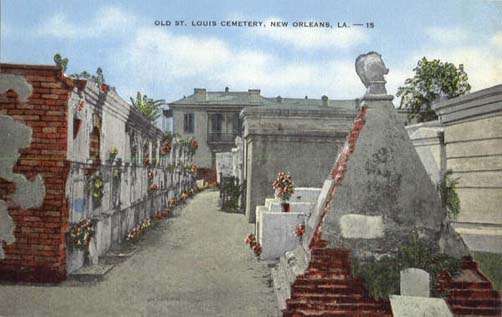
Caption on the reverse side: ‘The most interesting of New Orleans’ historic burial places, the St Louis Cemetery No. 1 – there are three – has been in use for 175 years, with some of the inscriptions still decipherable dated 1800. Here lie the bodies of Paul Morphy, the famous chessplayer; Gayarre, the historian; Etienne de Boré, who first made granulated sugar; Charles LaSalle, brother of the famous explorer.’
The card belongs to the same series (‘New Orleans – America’s Most Interesting City’) as the two we presented in C.N. 3014:

‘Famed patio and garden located at 417 Royal Street to which thousands of tourists are attracted annually. The building which once housed the Louisiana Bank established in 1804, and which later became the home of Paul Morphy, world-famous chess champion, is now used as a restaurant.’

‘This building located at 417 Royal Street, first housed the Louisiana Bank, established in 1804 through the influence of Thomas Jefferson, later it became the home of Paul Morphy, world-famous chess champion. It is now a fashionable restaurant. Your host, Col. Ad Given Davis.’
Below is a photograph of the house which was published on page 34 of the 1926 booklet Life of Paul Morphy in the Vieux Carré of New-Orleans and Abroad by Regina Morphy-Voitier:

We have received from Gordon W. Gribble (Hanover, NH, USA) a number of photographs taken by him in New Orleans in August 2002 (the Royal Street premises having become Brennan’s restaurant):
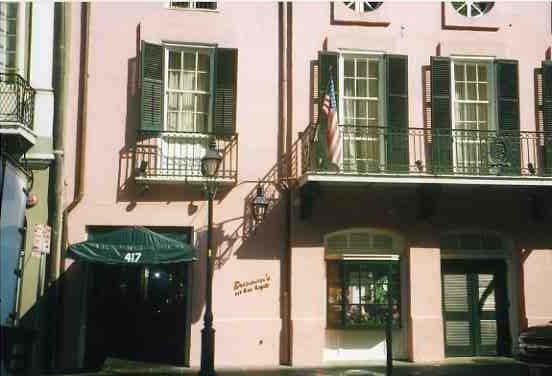
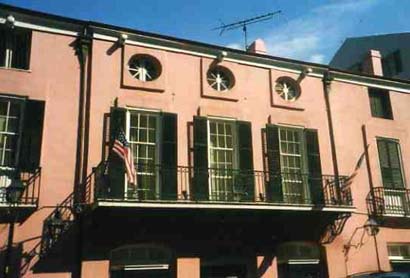
Dr Gribble has also kindly sent us shots of the Morphy tomb in New Orleans:
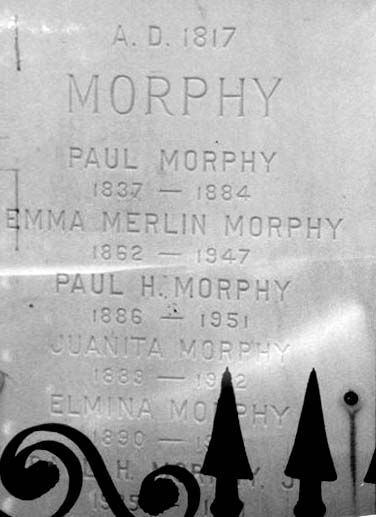
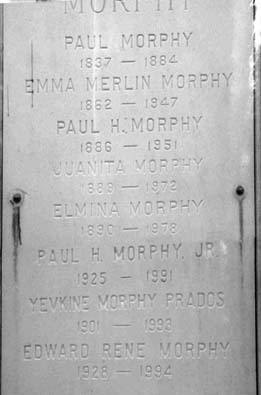
Neil Brennen (Spring City, PA, USA) offers the following early mention of O. Wurzburg, in the Denver Republican, 2 October 1887:
‘Master Otto Wurzburg, aged 12, William A. Shinkman’s nephew, is said to possess great talent as a composer, and C.G. Hallock, 13 years of age, took the first prize in the last tournament of the Minnesota Chess Club.’
Mr Brennen also quotes from Yenowine’s Illustrated News,
8 February 1891 an early composition by Palmer Gunkel Keeney:

Mate in two.
The News commented:
‘The 13-year-old son of the eminent composer Dr E.W. Keeney. This promising youth embodies all the virtues, strategic instincts and good looks of his illustrious sire.’
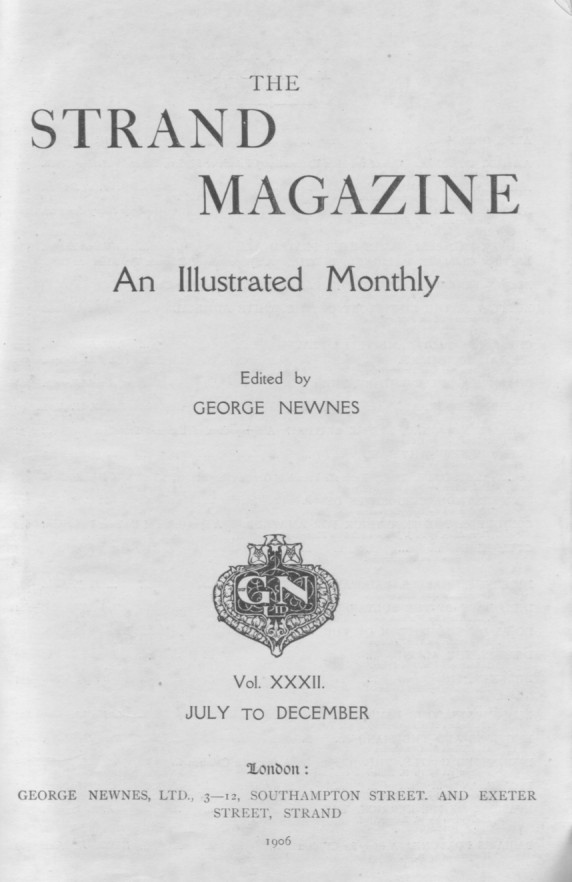
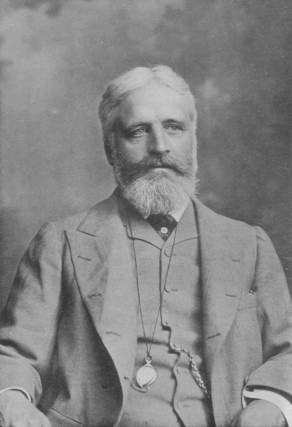
The Strand Magazine, the monthly periodical of the chess patron Sir George Newnes, Bart. (pictured above), seldom had articles on chess, but one such was published on pages 722-725 of the December 1906 issue:
‘The Best Games Ever Played at Chess by J.H. Blackburne, British Chess Champion [sic]
Brilliancy in chess is a rarity. It is like the sparkling of a multi-faceted diamond, which can illume darkness and shine best under provocation. Electricians would say it is the bright spark that signalizes the overcoming of resistance. It is not a very common or ordinary experience. It would cease to be a wonder if it were. It would fail to command the great admiration usually bestowed on things of rarity.
The best quality of brilliancy occurs between great contending forces – the powers of antagonistic minds. And so it is that, generally speaking, the highest products issue from conflict wherein very great players are engaged – players accustomed to exert very strong powers of mind against their adversaries. There is then the pressure of strong and skilful opposition provoking strong display, until at length out flashes the brilliancy which thrills the spectators as well as the producer, and sometimes has almost a benumbing effect upon the vanquished player.
Brilliancy in actual play very often prevails in spite of a flaw – the dazzling effect, as it were, rendering the flaw invisible.
Sound or flawless brilliancy in chess is the brilliancy that deserves the fullest consideration. The production of it sheds lustre on the happy producer, while it also serves a high educational function in giving us something to admire and study.
The alternation of stroke or “move”, combined with the necessity of parrying as well as delivering the stroke, has brought about in chess a practice of adopting aggresso-defensive tactics. It has developed an even higher ideal. It has led to the adoption, wherever possible, of a doubly attacking move – such as that of a knight forking two of the adverse pieces, or that of a bishop attacking or pinning on the one diagonal two or more of the opposing pieces. And, better still, it has led to the adoption, wherever possible, of such forking or raking moves as will include a check, or double check, to the adverse king; and, higher still, a move which, under every conceivable circumstance, will enable the player next moving to adopt one of these many-purpose moves.
It is chiefly in pursuit of some of these advantageous moves that brilliancy occurs. It may occur as a means of withdrawing, or paralyzing, or obstructing some of the hostile pieces, so as to get them out of the way or nullify their action, or make them embarrass their own king’s mobility. Design is the prolific source of ingenious brilliancy; yet, in a minor degree, luck contributes to the production. Some of these observations can be tested in examining the sample games appended.
Joseph Henry Blackburne
Meanwhile a few words as to famous exponents of brilliancy in the past.
First and foremost comes the immortal Morphy, who in 1858 came over from America and overwhelmed all the European masters, or, at least, those who cared to oppose him. His games were splendid specimens of brilliancy; and probably many of his sparkling gems will be reproduced, studied, and admired when the efforts of the so-called “position player” and the “accumulator of minute advantages” school have been forgotten. Then there was Labourdonnais, the renowned French expert, who also vanquished all-comers; and what chessplayer has not received pleasure and instruction in playing over the games of Professor Anderssen and his illustrious pupil, Dr Zukertort?
Then, again, there was Captain Mackenzie, a Scot by birth, an enthusiastic disciple of Morphy, and who became champion of America after that master’s retirement.
De Vere, at one time British chess champion; the two Macdonnells, both Irishmen; Pillsbury, and Baron Kolisch were all worthy exemplars of brilliancy.
And last, though not least, the young Hungarian, Charousek, who a few years ago startled the chess world by his aggressive and hazardous play against older and more experienced masters, and justly earned the title of the “New Morphy”; and, considering his short chess career, has left us wondering what he might not have attained had he lived.
To living masters like Bird, Maróczy, Marshall, Janowsky and Chigorin, it is hard to do justice without seeming to indulge in flattery; yet it is not possible to omit them and give anything like a true account of chess brilliancy. We have in England for nearly two-thirds of a century enjoyed the splendid style of Mr H.E. Bird, especially notable for his originality. He may by his devotion to brilliancy have several times missed the chess crown. He has always apparently set less value on that than on the achievement of some brilliant mate. The same may be said of Chigorin, the famous Russian player. Marshall and Janowsky have given us many pieces of rich brilliancy, and Maróczy for his time has pretty well earned a title to brilliancy. But for him the future has still much in store.
Brilliancy does not appear to be on the wane. The new school (as a fresher one than the “modern”) is distinctly endued with love of adventure and brilliancy. The younger players, under its healthy influence, are able, when taking part in tournament play, to infuse life and brilliancy into their games and suffer nothing as a penalty for rashness. It is a good sign, and possibly portends further improvement in this direction.
I will now proceed to consider three games which stand on record as perhaps the most brilliant in the annals of chess.’
The three were Anderssen’s Immortal Game (‘This is considered by many to be the most beautiful ending ever played’), Zukertort v Blackburne at London, 1883 and Morphy’s ‘brilliant little gem’ against the Duke and Count at the Paris Opera.
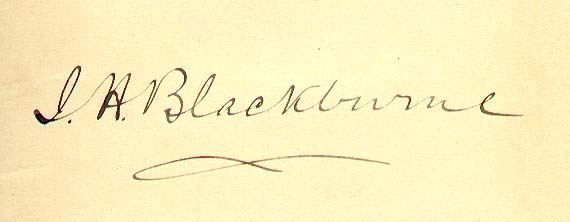
Readers are invited to try their hand at identifying all the masters in this line-up:

A number of games played by Daniel Starbuck (1856-84) appeared on pages 271-273 of A Chess Omnibus, with two further specimens in C.N.s 2936 and 3466. Now Neil Brennen (Spring City, PA, USA) has found three more:
Daniel F.M. Starbuck – Walker1 e4 e5 2 f4 exf4 3 Bc4 Qh4+ 4 Kf1 d5 5 Bxd5 Bg4 6 Nf3 c6 7 Bc4 Qh5 8 d4 Bd6 9 e5 Bxf3 10 gxf3 Qh3+ 11 Kf2 Qh4+ 12 Ke2 Be7 13 d5 Nh6 14 d6 Bd8 15 Nc3 O-O 16 Qf1 Na6 17 Rg1 Qxh2+ 18 Rg2 Qh5 19 Qg1 g6 20 Rh2 Qg5 21 Qh1 Kg7 22 Ne4 Qf5 23 Rxh6 Rh8
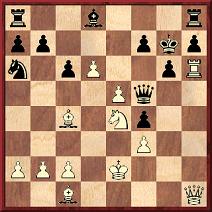
24 b4 Bg5 25 Bb2 Bxh6 26 e6+ Kg8 27 Qxh6 Resigns.
Source: Illustrated Graphic News, 15 January 1887.
Daniel F.M. Starbuck – D. Phillips1 e4 e5 2 f4 exf4 3 Bc4 Qh4+ 4 Kf1 Nc6 5 d4 d6 6 Nf3 Bg4 7 c3 Bxf3 8 Qxf3 Nf6 9 Bb5 a6 10 Ba4 Nd7 11 Bxf4 Be7 12 Nd2 O-O 13 d5 Nce5 14 Qe3 Nc5 15 Bc2 Qf6 16 h4 Ng6 17 g3 Nd7 18 Ke2 Nxf4+ 19 gxf4 Qg6 20 Rg1 Qh5+ 21 Nf3 Rae8 22 Kd2 c6 23 dxc6 bxc6 24 Nd4 c5 25 Nf5 g5 26 Bd1 Qg6 27 Nxe7+ Rxe7 28 Rxg5 Rfe8 29 Bc2 Qxg5 30 hxg5 Nb6 31 Qh3 Nd7 32 e5 Nf8 33 Be4 dxe5 34 f5 Rd8+ 35 Kc2 Red7 36 f6 c4 37 b4 Rd2+ 38 Kc1 Re2 39 Qh6 Resigns.
Source: Illustrated Graphic News, 12 February 1887.
Daniel F.M. Starbuck – S.1 e4 e5 2 Nf3 Nc6 3 Bc4 Bc5 4 b4 Bd6 5 O-O Nf6 6 d4 O-O 7 dxe5 Nxe5 8 Nxe5 Bxe5 9 f4 d5 10 Bb3 Bg4 11 Qd3 dxe4 12 Qxd8 Raxd8 13 fxe5 Nd5 14 a3 h6 15 c4 Ne7 16 Bc2 Bf5 17 Nc3 Bh7 18 Nxe4 Ng6 19 Bb2 Rfe8 20 Ba4 c6 21 Nd6 Re7 22 c5 Nf8 23 Bb3 Bg6 24 g4 Rb8 25 h4 h5 26 gxh5 Bxh5 27 Nf5 Rd7 28 Nxg7 Rd3 29 Nxh5 Rxb3 30 Rf2 Ne6 31 Nf6+ Kh8 32 Kh2 Rd8 33 Ne4 Rdd3 34 Rg2 Rh3+ 35 Kg1 Rxh4 36 Nf6 Ng7
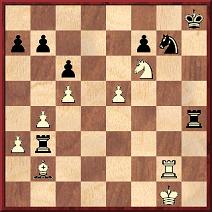
37 e6 fxe6 38 Nd7 Rh7 39 Nf8 Rbh3 40 Nxe6 and wins.
Source: Chic, 17 December 1887.
Mr Neil Brennen also forwards this game, annotated by Gustavus Reichhelm in the Philadelphia Times, 20 November 1898:
Ching-Chang – J. Hall1 e4 e5 2 Nf3 Nf6 3 Nxe5 d6 4 Nf3 Nxe4 5 d4 d5 6 Bd3 Bg4 7 h3 Bh5 8 g4 (‘Had Mr P-, we mean Ching-Chang, suspected the prowess of his adversary, it would not thus lightly have pushed the pawns.’) 8...Bg6 9 Ne5 Bd6 10 Nxg6 hxg6 11 Qf3 Qe7 12 Be3 Nd7 13 Nc3 Bb4 14 Bxe4 dxe4 15 Qe2 f5 16 a3 Bxc3+ 17 bxc3 Nb6 18 c4 O-O-O (‘About this time the barker, boosters, and even the “young” attendant began to look anxiously at the game. The figure had met an opponent worthy of its steel.’) 19 c5 Nd5 20 c4 Nxe3 21 fxe3
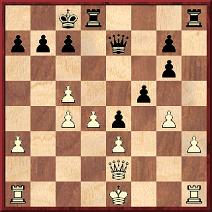
21...f4 (‘A masterly move, quite in the vein of Mr Hall’s brilliant style. If Chingy takes this pawn Mr Hall proceeds with ...e3, etc.’) 22 Qf2 g5 23 Rb1 c6 24 Rb3 Rhf8 25 Qb2 fxe3 26 Rxe3 Rf3 27 Rxf3 exf3+ 28 Kf2 Qe4 29 Re1 Qf4 30 Rb1 Rd7 31 d5 Re7 and wins. (‘Ching-Chang, however, fought it out for over 20 moves before it had the grace to resign. It was so unaccustomed to defeat, you know.’)
Ching-Chang, as Mr Brennen points out, was an automaton (see, for instance pages 76 and 170 respectively of John Hilbert’s books on Napier and Marshall). A question raised by our correspondent is whether Reichhelm’s note at move eight was a hint that the conductor of the white pieces was Pillsbury.
Chess Notes Archives:
| First column | << previous | Archives [12] | next >> | Current column |
Copyright 2005 Edward Winter. All rights reserved.